


























this year’s general election.
GOVERNMENT AND ag sector leaders’ vision of a deal pricing on-farm greenhouse gas emissions – via the highly controversial He Waka Eke Noa (HWEN) agreement – appears to be dead in the water.
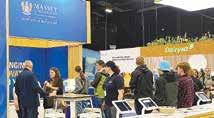
News of the troubles surfaced last week with the Politik website reporting that the Government faced a breakdown in negotiations with farming groups on the HWEN deal.

“The consequence is likely to be that the Government will now have to impose a new fertiliser levy on all farmers. In effect, this would be a tax,” the website claimed.
Last October, the Government insisted HWEN would be in place by the end of this year, ready to come into effect in 2025.
However, it is now believed there isn’t enough time to implement the legislation before Parliament rises for
Speculation about HWEN’s demise was further fuelled by public comments from Beef+Lamb NZ chair Kate Acland claiming that He Waka Eke Noa would not be legislated before the election.

The apparent failure on an agreement on farm emissions could see the implementation a fertiliser tax. Rural News understands that unless a lastminute deal can be stitched together, there is a possibility that government will act unilaterally and legislate for a fertiliser tax.
However, in Parliament last
week, Agriculture Minister Damien O’Connor appeared to pour cold water on this idea. While he confirmed he’d been working on the possibility of a new tax on nitrogenous fertiliser, O’Connor said ag sector groups had told him they didn’t want it and that he’d “probably not” progress the idea to Cabinet colleagues.
Acland told Rural News that Beef + Lamb New Zealand was committed to playing is part in addressing agricultural emissions.


“ However, we still believe the current methane targets are too high and do not reflect the latest science
when it comes to methane’s warming impact on the planet.”
Acland says there has been no concrete proposal in relation to emissions pricing from the Government, aside from indications of a potential tax of around $150/tonne on urea.
“Preliminary analysis of this suggests that this would have a significant impact on domestic food prices and farm profitability, particularly on our mixed arable systems, and raise an unjustifiably large amount of money, which we could not support,” she added.
“We are still committed to a
partnership approach in addressing agricultural emissions.”


Meanwhile, staunch opponents of HWEN, Groundswell, have cautiously welcomed the news of HWEN’s demise.
“It is too early to celebrate, but we think we are allowed a little hope,” Groundswell co-founder Bryce McKenzie said in an email to members last week.
Ironically, last week Stats NZ reported that agricultural emissions in 2022 had fallen by 1.6% - with the reduction attributed to the sheep, cattle and grain sectors.
Surprised, excited and still sinking in! That was the reaction of Otago sheep and beef farmers Steven and Kellie Nichol to winning the coveted Gordon Stephenson Trophy at the recent Ballance Farm Environment Awards. The Nichols headed off nine other winners from the regional awards, which were held over recent months. The awards evening held at Te Papa in Wellington attracted around 300 people – including friends and supporters of the finalists, as well as agribusiness leaders. – See full story page 11
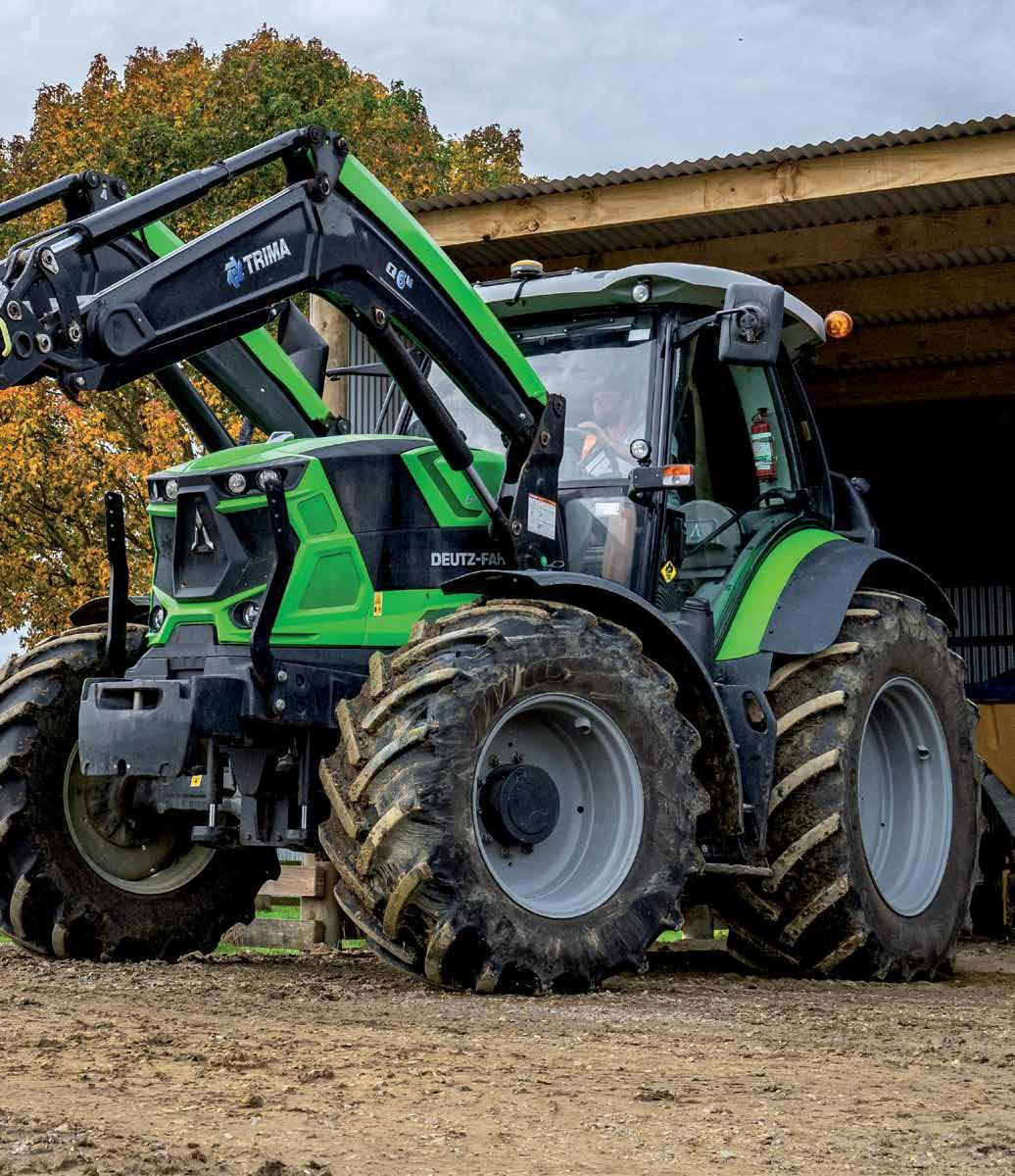

FARMERS HAVE been told that an opening forecast milk price of $8/kgMS this season hinges on China’s demand for whole milk powder (WMP) bouncing back.
Two milk processors – Fonterra and Open Country Dairy – currently have a mid-point of $8/kgMS. Synlait also came out last week with an $8 forecast milk price for the season that started June 1.
Fonterra Co-operative Council chair John Stevenson says farmers will be looking carefully at their budgets heading into the new season.

“Fonterra has told farmers that this forecast reflects an expectation that demand from China for whole milk powder will lift over the medium term, but that the timing and extent of that is uncertain,” Stevenson says.
Fonterra has opened with forecast price range of $7.25 to $8.75/kgMS. Open Country, which pays its suppliers in full four times a season, is forecasting $7.80 to $8.20/kgMS for milk supplied between June and September and paid in full in November.
Synlait notes that reaching this season’s forecast milk price requires an improvement in commodity prices from current levels throughout the season, which will require increased global demand.
After peaking in March 2022, dairy commodity prices have trended significantly downward with robust improvements in global production currently outweighing the first signs of increased demand, before appearing to find a floor around current levels.
Synlait chief executive Grant Watson says its farmer suppliers have received, on average, $0.28/kgMS in premiums above the base milk price for the last two seasons. He is forecasting to pay similar premiums for the next two seasons.
“We maintain a market-leading position in this space, which creates increased options for our farmers supplying Synlait’s world-class facilities in Dunsandel and Pokeno, enabling us to work with our farmers to add more value to the milk we receive. We are committed to delivering a competitive milk price.”
Fonterra chief executive Miles Hurrell says its opening forecast reflects an expectation that China’s demand for whole milk powder will lift over the medium term.
“We expect demand to gradually strengthen over the course of FY24 as

China’s economy continues to recover from Covid-19.
“However, the timing and extent of this remains uncertain, with China’s in-market whole milk powder stocks estimated to be above normal levels following increased domestic production. This is reflected in our wide opening forecast range for the season.
“We recognise the pressure farmers are under and have designed a new Advance Rate guideline to get cash to farmers earlier in the season.”
Stevenson notes new Advance Rate schedules will be appreciated by Fonterra farmers.
“It shows that board and management have heard council and farmer feedback that the co-op needs to get more cash to farmers earlier.”
ASB economist Nat Keall remains cautions on the outlook for the Chinese economy, noting that April data was lower than expected.
He believes farmers should budget on “a price with a ‘7’ handle on it”.
“We still expect a milk price at or below the bottom of Fonterra’s forecasting range. We are cautious on the outlook for the Chinese economy, with April data printing below market expectations.”
BEEF+LAMB NZ claims it has been told by at least one group of farmers that they should keep negotiating with the Government on the contentious issue of dealing with agricultural emissions.
The issue has been in the headlines in the past week with rumours that the Government has lost patience with the primary sector negotiators and is considering introducing a fertiliser tax.
Meanwhile, B+LNZ has begun holding a series of farmer meetings around the country to get feed-
back on key issues affecting their levy payers. A big one which has been identified is He Waka Eke Noa (HWEN). At a meeting in Southland last week, B+LNZ chief executive Sam McIvor – who was at the meeting – told Rural News that the message from the meeting was clear: ‘we want you to keep negotiating with others and not get into a position which forces the Government to act unilaterally.’
McIvor says B+LNZ’s bottom lines on HWEN include farmers being recognised for sequestration on their properties, and ensuring that money raised by a levy is put into agricultural research
POOR INFRASTRUCTURE has the potential to bring the country to its economic knees.
That’s the warning from Richard Burke chief executive of Leaderbrand – a major fresh vegetable grower based in Gisborne but with sites in Pukekohe, Matamata and Canterbury. He says infrastructure is a massive issue in this country and if New Zealand is going to be more efficient it needs to find the capital to invest in this area.
“We have been having some poor weather and there is lot of commitment to fixing some stuff,” Burke told Rural News
“But take the problems with the Cook Strait ferries. That’s been a real issue for us in terms of managing logistics and servicing our customers and it is certainly raising a lot of concern
from our customers about our reliability because we can’t get product across Cook Strait in a reliable manner.”
Burke says Gisborne has real problems with access to other centres – highlighted by road link to Hawke’s Bay being cut by Cyclone Gabrielle. He says there is a lot of work needed and it’s not just about restoring the present road. He believes there is a need for a much bolder approach to make sure that critical food supply areas have secure allweather access.
Burke is going to keep advocating for change and more investment to ensure companies like his can get fresh product to market year round and on time. He has taken this issue up with government, but admits they are in something of a bind with mul-
or on-farm changes that reduce emissions.
tiple requests from everywhere to spend money.
Burke says Leaderbrand is investing in dealing with climate change by looking at regen agriculture, which he hopes will help in the long term. They are also investing in covering some of their land. But Burke says all of this will be for naught if they can’t get product to market.
“As a region we are not sitting here and saying ‘you have to do infrastructure for us because we are poor guys on the East Coast’,” Burke adds.
“We are saying we are a critical part of the food supply in NZ especially in salads, fresh, citrus and some of those other things,” he says. “So, we need that allweather access otherwise that food supply is going to be challenged.” – Peter Burke
The farmer meetings are a closed shop
for levy payers only; no media or rural professionals allowed despite the meetings being advertised publicly. This reporter travelled 150km to a meeting only to be turned away, based on the strange premise that media presence would stifle farmer responses.
McIvor says the meetings are designed to get general feedback and to help better connect the leadership of B+LNZ with farmers – a concern that was raised at the organisations recent AGM. He says Southland farmers expressed their frustration at the Government’s action over winter graz-


ing consents and freshwater issues.

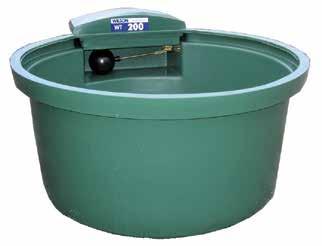


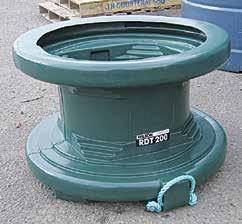

“Overall, farmers are feeling that bow wave of regulation coming forward and they are concerned about the quality and the lack of understanding by decision makers on what farmers are doing and how they operate. This is leading to uncertainty which in turn is constraining quite a bit of future decision making.”
McIvor says farmers feel the good news about what they are doing is not getting out to the wider public and have tasked B+LNZ with upping the ante on this.
THE COUNTRY’S export apple crop has taken a big hit as a result of the damage caused by Cyclone Gabrielle.

Apples and Pears NZ chair Richard Punter says before Cyclone Gabrielle, his organisation had an early estimate of 20.30 million TCE’s (tray carton equivalents of apples). However, the latest figure points to the export crop being down to 15.8 million TCEs.
He told Rural News the numbers may still vary in the coming months as reports come in of how apple trees have survived the cyclone. Some trees have either been wiped out by the cyclone or have subsequently died
because their roots were waterlogged or covered in silt. Some trees survived this damage, but any fruit that was under the floodwaters had to be written off.
Meanwhile, Punter has welcomed the Government’s recently announced near billion dollar package to repair infrastructure saying an important part of getting fruit to market is having good roads and bridges. Talks between government officials are ongoing and another round of talks with growers is scheduled in the next few weeks.
However, Rural News is aware of mounting frustration from growers and orchardists at the time it’s taking officials to come up with a
viable recovery plan. One person told us they felt like nothing had happened in the two months
since the cyclone. Others have complained that the officials have no understanding of what’s
needed. “They don’t seem to comprehend that reinstating a pumpkin patch is vastly different to rein-
stating an apple orchard,” complained one grower.
They went on to say that the bureaucrats can’t seem to comprehend that with an apple orchard, the land has to be cleared, new structures erected, new trees ordered and then planted and that it could take ten years before the grower gets a commercial crop.
And there is the cost.
It’s well known that any income earned in the first six years will simply be used to pay off debt.
Punter says he’s aware of the frustrations of growers and says some are seeing what’s ahead of them as almost impossible to deal with. He says Finance Minister Grant Robertson recently acknowledged that growers can’t be expected to
fund all the costs of the recovery.
“What’s needed is some very clever financial engineering to make capital available to growers that can be paid off over time,” says Punter.
To try and get everyone working off the same page in the recovery, NZ Apples and Pears is preparing a basic leaflet setting out step-by-step the actions, timing and costs involved in reinstating an orchard – a dummies’ guide to orchard reinstatement, if you like.
Punter hopes this 101 paper on how best to deal with the recovery of orchards will help speed up the process and lead to outcomes that work for the many growers who are facing hard and uncertain times.
NO SURPRISES, it’s been a bad year for the kiwifruit sector with the final numbers recently released by Zespri.
These show that total global revenue from fruit sales for 2022/23 was $3.92 billion – down 3% on the record result in the previous season. Global sales volumes were also down, from 201.5 million trays to 183.5 million trays.
Zespri say that the value of kiwi-
fruit lost because of quality issues in 2022/23 was $534 million – well up from the $307 million in the previous season. To top it off, increased costs also reduced grower returns with the return per tray for Zespri Green in 22/23 $5.78, compared to $6.35 the previous year, while returns for SunGold were $9.97, down from $11.51 in 21/22.
Zespri chief executive Dan Mathie-
son says the results are indicative of what’s been a very difficult period for many primary industries, with growers facing challenges relating to the labour shortage, the ongoing impacts of Covid-19, the climate and rising costs.

“This was one of our toughestever seasons and the industry worked incredibly hard to deliver our fruit to market, despite facing an extraordi-
nary number of challenges, including a significant labour shortage.”

Mathieson says the results illustrate the importance of the industry’s efforts to improve quality, which remains a key driver in delivering stronger returns in future years.
He says this is a challenging period for growers, particularly Green growers, given the fact there will also be lower volumes of fruit in
the 2023/24 season.
“While conditions remain challenging, the first shipments of the 2023/24 season have been well received by our customers, indicating initiatives from the industry’s Quality Action Plan are helping reduce quality costs and keeping poorer quality fruit onshore,” he says. – Peter Burke
@rural_news
facebook com/ruralnews


“WE THOUGHT last year was bad, but this is the highest on-farm inflation rate for sheep and beef farmers in 40 years.”
That’s the view of
B+LNZ chief economist Andrew Burtt who says latest data shows that onfarm inflation is running at 16.3% - two and a half times the consumer price inflation rate of 6.7%. The last time on-farm inflation was this high was back in 1981 when it was 17.1%.
Burtt says to make matters worse, B+LNZ is forecasting a 30% decrease in average farm profit based on estimated on-farm inflation of 12–13%, but the latest numbers mean farm profit is likely to fall even further. He says costs increased across the board this year, the largest being interest (+86.5%), which contributed substantially to the overall increase in onfarm inflation because it comprises 10.9 % of total farm expenditure.
“Floating interest rates doubled from March 2022 to March 2023 while fixed and overdraft interest rates increased by around 50%,” he explains. “Feed and grazing (+14.8%) and fertiliser, lime and seeds (+14%) were the next two largest increases for the year. With inflation eroding farm profitability, farmers continue to tighten their belts.”
This is the latest in a series of reports highlighting the financial and regulatory pressures
facing sheep and beef farmers. B+LNZ chief executive Sam McIvor says the significant financial challenges facing farmers, with many also working to recover from Cyclones Hale and Gabrielle, are another reason
the Government must put the brakes on its raft of environment policy changes.
“The financial pressure is challenging. A generation of farmers have not operated under this level of inflation and the situation is further exacerbated by unworkable environmental rules,” McIvor says.
“When farmers are impacted in this way, it has a knock-on effect to the wider economy – including businesses that service farms, like vets, trucking companies, shearers and many more. It also impacts businesses where farmers spend their family incomes,” he says.
McIvor says sheep and beef farmers are playing their part to address climate change, improving waterways and protecting New Zealand’s biodiversity. He says B+LNZ are asking for urgent changes to flawed Government policies and poorly crafted rules.


“The Government must get behind the sector, which provides nearly one of every five dollars New Zealand earns from exporting, so farmers can navigate this financially challenging time, plan ahead and ensure their businesses remain sustainable, in every sense of the word.”
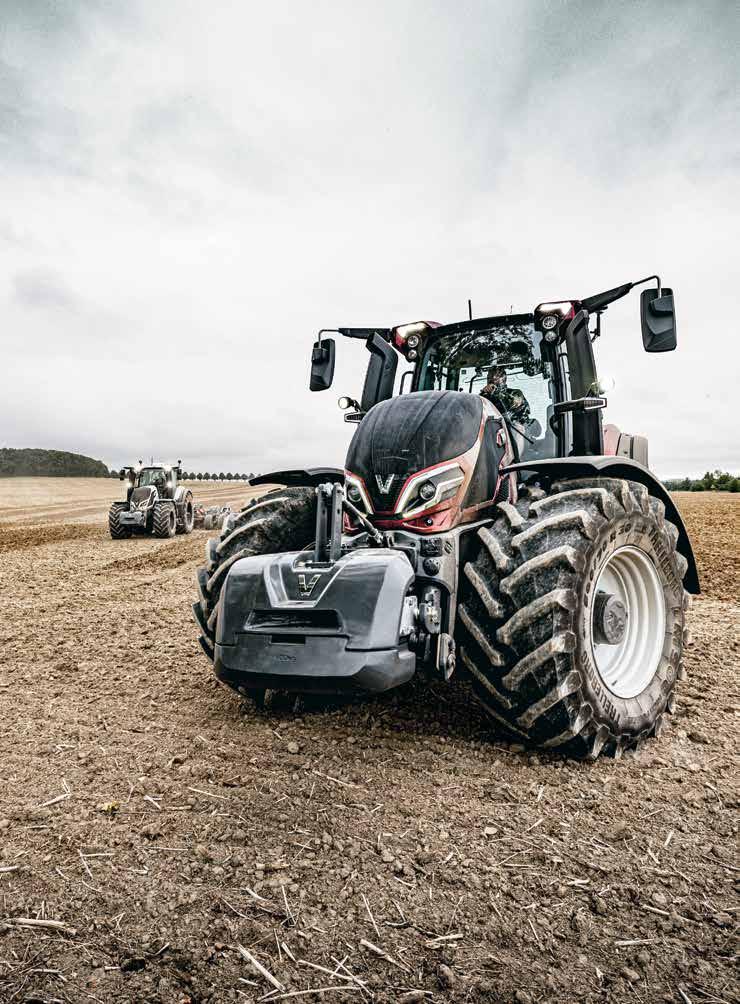
“When farmers are impacted in this way, it has a knock-on effect to the wider economy – including businesses that service farms, like vets, trucking companies, shearers and many more.”
NEW ZEALAND honey producers are “disappointed but undeterred”, while Australian beekeepers have welcomed a “common sense” ruling.

This come after the New Zealand’s Intellectual Property Office (IPO) recently decided that NZ honey producers have no exclusive claim to the term ‘manuka honey’.
The trademark win follows earlier Australian successes in other jurisdictions including the UK and Europe.
Recently elected Australian Manuka Honey Association (AMHA) chairman Ben McKee says his organisation is delighted with the judgment handed down by the IPO. He praised the decision as a “sensible outcome” that ensures
Australian beekeepers can market their produce, while following other precedents around the world that manuka honey is a descriptive term.
“What we have been saying since New Zealand producers began this legal process nearly eight years ago is, our product has a long history of being recognised as manuka honey,” he told Rural News

“It is produced like the NZ product is and it also offers the soughtafter antimicrobial properties that consumers around the world value so highly.

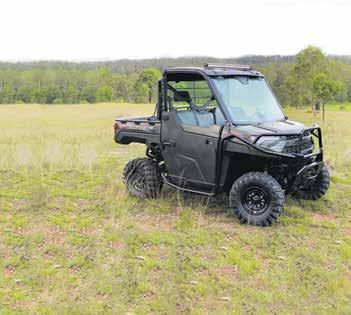
“The fact that even authorities in New Zealand cannot find a way to support the trademark claims of NZ producers should, we hope, bring this legal dispute to an end once and for all.”
International manuka
honey markets are forecast to be worth $1.27b by 2027.
However, chair of the Manuka Charitable Trust Pita Tipene claims its role as caretakers of taonga species on New
Zealand’s behalf was “not contestable” and that the findings reflected “technicalities and limitations of conventional IP law to protect indigenous rights”.
“If anything, it has
made us more determined to protect what is ours on behalf of all New Zealanders and consumers who value authenticity. We will take some time to absorb the details of the ruling and consider
our next steps.”
McKee has expressed disappointment with these statements, calling them and the ongoing legal fees the Australian industry are paying in these appeals “frustrating”.

He adds that although they will “continue our opposition”, what Australian honey producers really wanted was to grow the manuka industry.
“We can do that better together. At some stage though, we may have to accept that without a change in industry management, working with Australia may not be a priority from some in NZ.”
McKee says growing research highlighting the unique health benefits of manuka honey has led to strong demand for Australian honey from countries around the world.
He also points to a study in PLOS One (an open access peer reviewed journal) from 2016 that found 22 of 80 Australian honey samples matched or even exceeded New Zealand honey in critical MGO levels – albeit with only two NZ samples as controls.
“The opportunities for Australian Manuka honey are huge. Hopefully we can now focus on promoting this wonderful medicinal honey to the world, rather than fighting over naming rights.”
McKee claims that the AMHA and Australian Minister for Agriculture have attempted to reach out to their NZ counterparts for communications but had not gotten a response.

Rural News asked NZ honey representatives for comment but they had not responded.
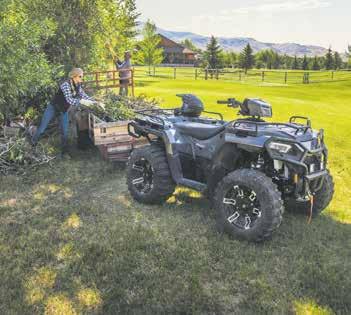
FARMERS ARE being urged to consider other options to support ewe performance over lambing, following a ban on the sale and use of Bionic Capsules.
“We know farmers who stocked up on Bionics will be very disappointed by this news,” says Dr Ginny Dodunski, experienced sheep veterinarian and manager of the Beef + Lamb New Zealandfunded Wormwise programme.

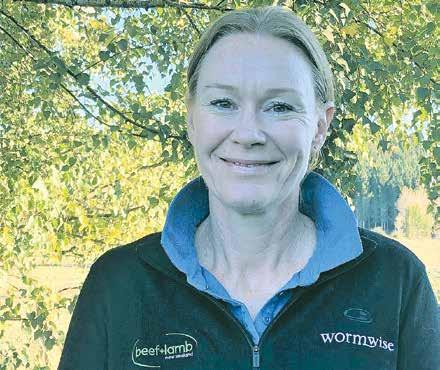
“Farmers need to be aware that they cannot use these capsules even if they have already purchased them.”
In January, Wormwise flagged the unavailability of Bionics as both a threat and an opportunity to farmers who traditionally rely on them to support ewe performance over lambing.
MPI has now issued an alert banning their sale and use.
“To farm successfully when these products are withdrawn from a system involves a strong focus on improving ewe body condition and setting up the farm to feed ewes properly coming into lambing and early lactation,” says Dodunski.
“Choosing genetics that are better able to deal with worm
challenges can also play a part. However, this is a medium to long term project on a farm and unfortunately we are now in a situation where farms will be squeezed for time to implement some of this.”
She says farmers need to consider the following:
• Body condition scoring of ewes at ram removal and again at scanning. Ewes that start the winter a body condition score of less than 2.5 are twice as likely as their better conditioned flock mates to be culled, dead or missing by weaning. Identify these, draft them out and make a plan to look after them, or quit them.
• Work out your daily feed demand for the next three months – is it greater or less than the daily pasture growth rate? Typically, it will be lower – where will that put you at lambing and what actions can you take to ensure there’s enough grass under ewes in those critical few weeks before lambing and into early lactation?
“There are other longacting products available if the gap between actual and ideal is going to be too big this year,” Dodunski adds.
“Get advice from an experienced sheep veterinarian on the best
way forward to carefully use these on the most vulnerable proportion of the flock and then put some dates in the calendar to review how this went. Most importantly, make a more sustainable plan for lambing in 2024.”
She says farmers
who would like training in any aspect of feed planning, body condition management and sustainable drench use are encouraged to contact their local B+LNZ extension manager for workshops in their area.


peterb@ruralnews.co.nz









OTAGO SHEEP and beef
farmers Steven and Kellie Nichol won the coveted Gordon Stephenson Trophy at the recent Ballance Farm Environment Awards. As such, they also become the 2023 national ambassadors for sustainable farming and growing

The Nichols headed off nine other winners from the regional awards,
but the couple keep in close contact with their manager.
Despite not physically managing Auldamor, the Nicols have done much to improve the quality of the farm, such as putting in new subdivisions and infrastructure, as well as several initiatives to improve soil health. This in turn has led to improved pasture resilience, better yields and improved stock perfor-
the ability to articulate ‘informed responses and insightful views on a range of pan sector topics’. The judges commended the Nichols for their passion for farming
with a holistic approach, bringing off-farm skills into the business.

“We know they can and will ‘walk the talk’,” said Dianne Kidd, chair of the judging panel.
which were held over the past months. The awards evening held at Te Papa in Wellington attracted around 300 people –including friends and supporters of the finalists, as well as agribusiness leaders.
Kellie Nicol says they weren’t expecting to win, given the high calibre of the other contestants and the stories about their properties. She was all smiles when she and Steven were announced the winners and admits she was shaking at the knees as they came up on stage to receive the Gordon Stephenson Trophy and the other prizes, which include funds for overseas travel.
Steven Nicol says winning the competition hasn’t sunk in. He says it was great to meet the other finalists before the awards dinner to hear their stories.
The couple’s 1498 hectare farm, Auldamor at Clarks Junction in Otago, has been farmed by the Nicol family since 1871. They run 4500 ewes, 1500 hoggets and 80 rams, as well as grazing an average of 290 mixed aged beef cows each year.
The couple live offfarm. Kellie is a doctor and Steven a farm consultant and the property is managed by Grant Bezett,
mance and health.
The property’s biodiversity has been enhanced through the planting of shelterbelts and forestry stands, along with significant fencing of native shrubland and waterways. Meanwhile, Steven is one of several local farmers participating in a project to reduce greenhouse gas emissions.
He says they really value their land and their goal is to preserve and enhance it for the next generation.
“One of the things I have learned by entering their competition is our family history and understanding the sacrifice and tireless work that has gone into being where we are today,” Nicol told Rural News. “We don’t take that for granted and we just want to build on that for the next generation.”
Steven and Kellie have defined what sustainability means to them by having a triple bottom line based on planet, profit and people. He says every decision they make on farm goes through this filter to ensure it meets their sustainability criteria.
As well as judging the on-farm performance of entrants, exemplary performance is required. The criteria includes having
“One of the things I have learned by entering their competition is our family history and understanding the sacrifice and tireless work that has gone into being where we are today.”

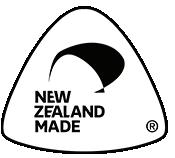











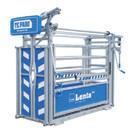




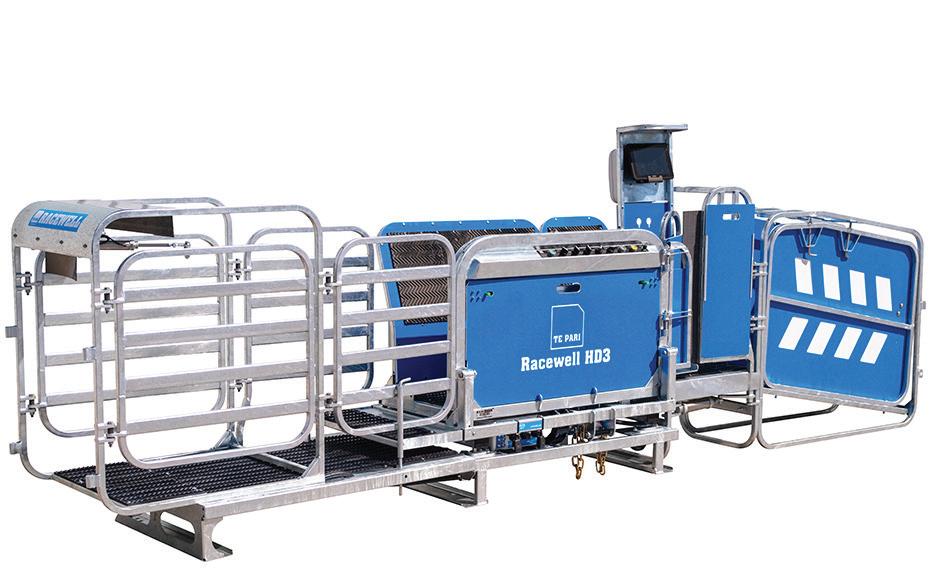

RABOBANK HAS announced an opening farmgate milk price forecast of $8.20kg/MS for the 2023/24 season, while also highlighting vastly changed global dairy markets.

In its New Zealand Dairy Seasonal Outlook 2023/24 report, titled The Pressure Is On, report author and senior agricultural analyst Emma Higgins says this forecast is due to farmgate prices catching up to global commodity market trends. She adds that prices are moving lower in 2023 in part due to global milk supply returning to growth in key production regions, while China rebalancing its internal markets is expected to subdue dairy demand until the latter
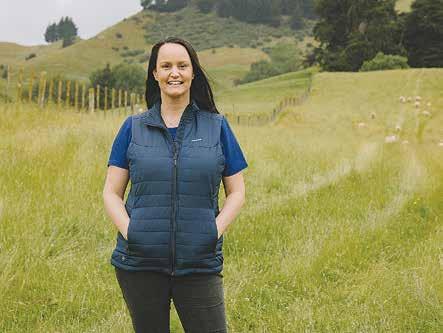
part of the year.
“At this stage last year, market fundamentals were very tight with limited supplies in export regions, aggressive import demand by Chinese buyers and supply chain issues exacerbating buyers’ urgency to procure raw materials,” Higgins explains.
“Since then, we’ve seen a return to growth in milk supply across most of the export regions, sluggish Chinese import volumes and widespread demand rationing in many other dairy markets across retail, foodservice and ingredient channels in response to food price inflation and higher sticker prices.”
She adds that global dairy market fundamentals are likely to remain under stress in the short-




term future.
As a result, commodity prices for whole milk powder (WMP) and skim milk powder (SMP) fell between 30 and 40% since peak commodity prices in 2022 and are now at or below the average price over the previ-

ous five years. Rabobank says farmgate milk prices are feeling the pressure in most export regions.
Higgins explains that milk prices in export regions have followed the commodity cycle. She says the cycle will turn and prices will rebound
– but the timing of this will hinge on meaningful imports from Chinese buyers, whose local inventories are being worked through.
“The short-term outlook suggests more pressure is possible, but later in 2023 we should see
more meaningful purchasing activity from China,” she adds. “Coupled with improved demand tension from other buying regions in the face of low buy-side inventories… these factors will help buoy global dairy markets as we move through this year.”
Higgins says China’s ability to increase domestic production will be impacted by New Zealand’s decision to end live exports. Combined Australian-New Zealand volumes in 2023 set a new record for herd expansion, with the equivalent of Taranaki’s annual milk production being added each year since 2018.
Beyond dairy market supply and demand fundamentals, Rabobank reports that a host of broader macroeconomic and geopolitical uncer-


tainties – including deglobalisation, central bank policies and the threat of war – present both upside and downside risk to the bank’s milk price forecast.
Given rapidly shifting dynamics, the report recommends farmers consider the possible impacts of central banks monetary policies in case of recession or inflation developments – as well as the possibility of conflict with China.
“The world has changed, and one thing is clear: the global trade architecture that we have grown accustomed to and comfortable with is changing, forcing New Zealand to re-evaluate trade relationships and diversify product mix and customers.”
@rural_news


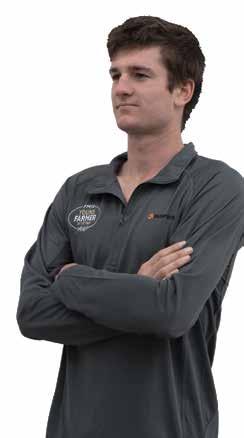
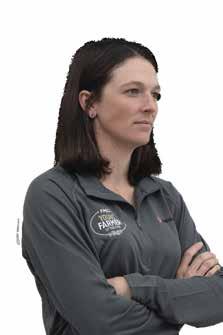



FMG Region-off teams up AgriKidsNZ, Junior and Young Farmer winners for a regional showdown. Provincial glory and a $5,000 prize for a good local cause are up for grabs. Vote now at fmg.co.nz/region-off

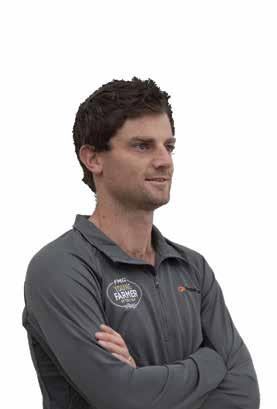

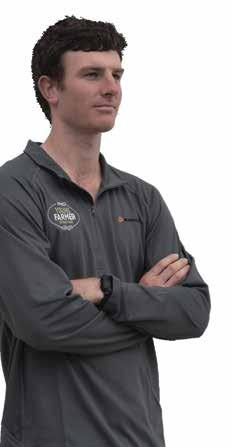
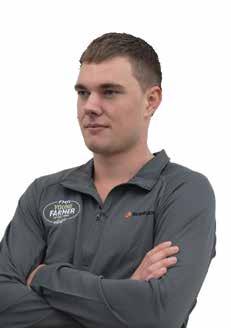
THE CENTRE for Climate Action Joint Venture (the JV) says it will invest up to $2.5 million to support research on developing a methane vaccine and methane inhibitor for use on New Zealand farms.
The research is cofunded by the New Zealand Greenhouse Gas Research Centre (NZAGRC) and is focused on reducing the methane emissions from cattle, sheep and deer in pasture-based farming systems.
The JV and the NZAGRC are two parts of the Government’s newly established Centre for Climate Action on Agricultural Emissions.
The JV is an investment fund established in February between Government and major agribusiness companies to help pasture-based farmers in Aotearoa New Zealand reduce their agricultural emissions by 30% by 2030.
The JV’s shareholders are ANZCO Foods, Fonterra, Rabobank, Ravens-
down, Silver Fern Farms and Synlait owning 50%, with the other 50% owned by the Crown through MPI. To date, shareholders have committed around $170 million over the next four years to the JV. Research into the methane vaccine has been undertaken since 2007 and is overseen by the Methane Vaccine Think Tank, a group of global vaccine experts. If successful, the methane vaccine would be a world first and would provide a simple, effective solution for New Zealand’s farmers to reduce their methane emissions from animals on farm and meet emis-
A PROPOSED recycling levy on commonly used polyethylene woven seed sacks and bags is likely to come into effect next year.

Meanwhile, the seed industry continues to investigate sustainable packaging options. Under an amendment to the Waste Minimisation Act, manufacturers who sell agricultural products with plastic packaging, including polypropylene (PPE) seed sacks and bags, will be required to pay a fee to an accredited organisation to collect and recycle farm plastic packaging.
General manager of the New Zealand Plant Breeders Research Association Thomas Chin says the association is committed to sustainability and industry best practices to achieving official waste minimisation obligations. He says the Government’s proposed farm plastic waste levy will have significant ramifications for users of polypropylene seed sacks and bags.
“Our understanding is that by the middle of next year there will be a man-
sions reduction targets.
The JV will also be investing in a research programme to develop potent inhibitors for delivery from intra-ruminal capsules that could be used by New Zealand farmers to reduce methane emissions from their grazing ruminant livestock.
Methane inhibitors or feed additives offer a real opportunity to lower emissions by reducing the activity of methane-producing microbes (methanogens) in the digestive systems (rumen) of ruminant livestock.
The JV’s executive director Wayne McNee says these investments align well with its focus
on supporting research and technology to develop practical tools to
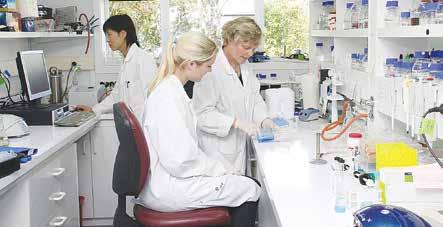
reduce agricultural emissions in New Zealand, for use by New Zealand’s pasture-based farmers.
“The research underway into a methane vaccine and methane inhibitor is producing promising results and our investment will provide the funding required for continuing this research.”
McNee says the ambition is to ensure all livestock farmers in NZ have equitable access to affordable, effective solutions to reduce biogenic
methane and nitrous oxide emissions, with a goal of supporting a 30% reduction by 2030 and enabling development and adoption of solutions to drive towards ‘near zero’ by 2040.
These new investments follow the JV’s announcement in April that it has invested $1.8 million in Ruminant Biotech, a New Zealandbased start-up that is developing a slow-release, biodegradable methaneinhibiting bolus.
“New Zealand’s global customers are setting ambitious greenhouse gas reduction targets, and if we can’t meet these targets export revenue will be under threat.
“We must confront this reality, and I believe we can meet the challenge,” McNee says.
“We’re focused on scaling up efforts made to date by Kiwi farmers and agri-researchers and forging ahead with investigating new opportunities and investments.”






datory regime in place for the recycling and recovery of plastic seed sacks and bags, with a compulsory levee charged to the importer or brand owner of the bags.”
Imminent requirements include companies importing, manufacturing and supplying bags to pay a levy on small seed sacks and bulk bags used domestically. The levy would be paid at the border or first point of handling into New Zealand to ensure 100% capture and pay for the collection and recycling. Most if not all of New Zealand’s plastic bags are manufactured abroad and imported into the country.
Chin says that for several years the New Zealand seed industry has been evaluating sustainable bag options such as multi-wall paper bags which are widely used internationally.
He says there are some physical challenges, such as robustness and moisture barrier properties, which are especially important for the storage of endophytic seeds. – Leo Argent

A SCHEME to help young people into jobs has been key to central Hawke’s Bay consistently having one of the lowest unemployment rates in New Zealand.
The ‘Jobs in Central Hawke’s Bay’ scheme has been successful in finding local jobs for local people,
The scheme is an offshoot of the Mayor’s Taskforce for Jobs (MTFJ) rural community resilience programme, a national project funded by the Government.
Walker says MTFJ was launched off the back of a difficult time for the district, following a period of drought for farmers with
Come visit us in the Rural Living Marquee - site RM89
We will have the team ready for a yarn about what’s happening at your place, as well as caps, beanies, shirts and bumper s�ckers for sale!
Don’t miss the Special Fieldays Edi�on o� �ol� �alls - if the budget doesn't stretch to a tractor we will

productivity falling and Covid-19.
Ministry of Social Development (MSD) statistics show that between June and July 2020 the number of people receiving Work and Income support in Central Hawke’s Bay increased, with it peaking at 919, an increase of over 40 in just one month.
“Since then, we have had nearly a thousand unique jobseekers approach us for support in finding employment –almost half of these were young people between 16 and 24-years-old, and we secured employment for just over 400 people,” says Walker.
“It has provided support to over 857 local businesses to grow by connecting them to jobseekers, networking events, regular economic updates, training and workshops. As a result, this has been key to Central Hawke’s Bay consistently having one of the lowest unemployment rates in New Zealand.”
Walker says it’s their “by local, for local” approach that has built a strong team and created a trusted channel for job seekers and employers.
Dr Tom Sheahen from the USA will also be on our site on Friday and Saturday. As well as talking over the road at the Airport Conven�on Centre on Friday night, on “Methane, the irrelevant GHG”
An opportunity not to be missed www.groundswellnz.co.nz

MENTAL HEALTH and wellbeing support for young people in rural areas is part of the Mayor’s Taskforce for Jobs (MTFJ) scheme.
Clearhead, a wellbeing provider founded in 2018, is helping improve access to care and wellbeing support.
Co-founder Angela Lim says NZ mental health statistics reveal that rural communities have high rates of stress and other forms of mental illness.
However, rural dwellers often have fewer locally available mental health services, especially for young people and Māori. Services, if they are available, can be sporadic, as they are frequently troubled by workforce shortages.
She believes technology can make mental health care and information more easily accessible by providing access to professionals across the country delivering online therapy, reducing cost, and
“Our MTFJ team know our community, know our people and our businesses, and know where and how to find support through our existing partners including MSD, local service providers and businesses.
“The team breaks down barriers between employers and job seek-



ers. It has achieved transformational change for our district both socially and economically and has had a strong influence on creating a growing positive ‘culture of work’ in our community.”
Jobs in central Hawke’s Bay extends
rewarding careers.
“We have also taken an approach which continues to provide practical support once people are in work and training – keeping them engaged, growing and more likely to be successful.
“For example, a weekly workshop for apprentices to get their paperwork done, learn from each other and create a positive social and professional network.”
Walker believes the programme has potential to grow in farming communities.

providing anonymity that encourages people to seek help earlier and therefore address the key barrier to care in rural areas.
Lim told Rural News that average wait time on Clearhead’s platform is two to three days compared to six months on the public mental health system via GP referrals.


When interviewing young people, there were multiple factors that prevented them from successfully entering the workforce or remaining in employment once they get a job.
However, they don’t get easy access to support to address these mental health related issues, says Lim.
A few of the common themes include lack of self-confidence and self-limiting beliefs, anxiety, search for purpose and identity, lack of motivation and poor conflict resolution skills.
beyond simply finding local jobs for local people. It removes hurdles for people looking for employment by providing support, encouragement, and ongoing training.

The programme offers driver licensing sup-

Driver Licensing, support with CVs, training opportunities, life coaching and counselling and personalised pathway plans.
Walker says they also support people once they are placed into their work to ensure they have
She says rural communities are all too familiar with government agencies who are either absent, or part-time run from another area.
“The MTFJ approach empowers a ‘by local for locals’ method for building a future for our young people in our small communities and has a huge future.
“From the beginning this project has been community-led and relevant to the needs of local people and rural businesses at its heart.
“Jobs in Central Hawke’s Bay has established itself as a local conduit for employment and support and continues to build rapport and a strong reputation within the community. We have been able to work collaboratively with local skills and training providers to ensure ongoing positive results for our community.”
3
The Ministry for Primary Industries will showcase the extensive work under way to strengthen the future of New Zealand’s food and fibre sector at this year’s Fieldays national agriculture show at Mystery Creek.
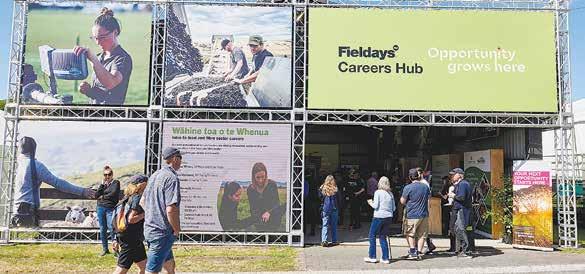
One focus of MPI’s Fieldays site will be the On-Farm Support services working throughout the country to ensure that farmers and growers have the information and support that they require to innovate and thrive.
Cyclone Gabrielle has been one of the biggest challenges faced by our farmers and growers in recent times, and MPI’s On-Farm Support advisors have been on the ground in affected regions to help rural communities as they navigate the recovery process.
As the Southern Hemisphere’s largest agricultural event, Fieldays remains the ultimate platform for cutting-edge technology and innovation being developed across the food and fibre sector.
MPI works closely alongside sector partners with investments through the Sustainable Food and Fibre Futures fund, helping to develop new products and technological solutions to drive New Zealand’s success.
Fieldays visitors will be able to learn more about SFF Futures, including whether their own innovative ideas could be eligible for co-investment. A range of funding options are on offer – from smaller projects that cost less than $100,000 to multi-million-dollar, multi-year programmes.

A particular focus will be efforts under way to drive innovation in New Zealand’s strong wool industry, aiming to create demand, develop new products, and add value for
MPI is inside the Pavilion, site PD25-PD33
Opportunity Grows Here Careers Hub, site E30
Forestry Hub, site G80
farmers.
Insights into projects from organisations including Wisewool, Bremworth, Wool Action, and Floc Wool Acoustic Panels will capture the diverse opportunities ahead for our natural fibres.
A series of SFF Futures projects backed by MPI will also be showcased at the nearby Fieldays Innovation Hub, highlighting exciting developments in areas including vertical farming, pharmaceuticals, sustainable packaging, and even truffles.
The Fit for a Better World roadmap charting a course to 2030 will be highlighted at MPI’s Fieldays site, with its targets focused on improving the productivity, sustainability and inclusivity of New Zealand’s food and fibre.
Biosecurity NZ will share upto-date information on risks facing our economy, the environment, and our way of life – including the threat posed by the brown marmorated stink bug, and biosecurity advice for lifestyle block owners.
Interactive displays from NZ Food Safety and MPI’s animal welfare teams will reinforce best practice to help visitors keep themselves and their animals safe.
Our food and fibre sector powers New Zealand’s economy, with export revenue hitting more than $53 billion to June 30 last year. With
that growth and momentum comes the need for an agile and diverse workforce.
Food and fibre careers and education opportunities within the sector and at MPI will be on show at the Opportunity Grows Here Careers Hub.
Fieldays and the Ministry for Primary Industries are partnering for the second time to provide an excellent platform for visitors seeking insights from those already working in the food and fibre sector.
Students, job seekers, and industry professionals will be able to connect as visitors learn more about the varied and different career pathways available across the primary industries.
The pace of innovation and evolving ways of farming are creating opportunities for people with diverse skill sets to forge exciting careers in food and fibre with opportunities from on-farm roles, science, technology, animal welfare, and research and development, to business management, logistics, and marketing.
Featured will be a series of
inspiring speakers each day from 9.30am to 2pm, with panel discussions and TED talk-type presentations also included.
The Opportunity Grows Here Careers Trail will provide visitors with an interactive experience to see the career pathways ahead of them, from hands-on roles in agriculture and horticulture, to technical roles in science and technology.
The Forestry Hub will host about 30 displays from 20 sector organisations under the theme of ‘Wood – our low-carbon future’,
The Ministry for Primary Industries (MPI) has published a new report exploring what consumer demand for food might look like in export markets by 2050, and what opportunities this might bring for Aotearoa.
The Long-Term Insights Briefing aims to help Aotearoa New Zealand’s food sector achieve long-term success.
“Our LTIB looks at consumption, market trends and preferences that could drive consumer food demand in 2050,” says Grant Bell, Manager Market Insights at MPI.
“We focused on the food sector given its significant contribution to the wellbeing of New Zealanders and the
contribution it makes to our economy and prosperity.
“Our food sector is the foundation of our export economy, hitting $42.3 billion in 2022 and representing 62.8 percent of our total export goods.”
Bell says the LTIB aims to help the public, producers, industry groups and decision-makers to consider medium and long-term trends, export opportunities and risks.
“Understanding what consumers will want in 2050 will help our food sector to think about the technologies, infrastructure, and capabilities we’ll need to meet future demand,” Bell says.
“The LTIB shows Aotearoa’s food
production is well-placed to respond to disruptions from climate change and other shocks compared with other foodproducing countries.
“Ongoing core consumer needs like security, safety, quality, taste, price and convenience, are still expected to influence end-consumer food choices in 2050.
“Our food sector is a good position as it plans for the future, but it’ll need to grow productivity, and maintain and build further resilience.”
To read the LTIB, check out www.mpi.govt.nz/ltib
with staff on hand to provide information about the forestry and wood processing sector.
Attractions will include a simulator for visitors to experience what it’s like to operate machinery in a forest, and several forums and ‘hot topic’ talks.
The hub is a collaboration between Fieldays, Te Uru Rākau –New Zealand Forest Service, Forest Growers Levy Trust, Scion, NZ Forest Owners’ Association, Red Stag, NZ Farm Forestry Association and Future Foresters.

MPI has launched Primary Matters, a podcast about the food and fibre sector, the people at the heart of it, the efforts to keep it thriving and safe, and to showcase the wide array of interesting roles in the sector to potential workers. Presented by former RNZ journalist Carol Stiles, the first series – Get Your Boots On – features six young people stepping out into careers in the primary sector.

Our next series – You Do What?! – profiles people with unusual yet crucial roles to protect the sector in Aotearoa New Zealand.
Future episodes will feature new projects, issues, research and people working on the land, at sea and in our forests.
The podcast is available on all major apps, and at https://shows.acast.com/primary-matters/episodes
WITH NATIONAL Fieldays around the corner, many farmers will be making their annual pilgrimage to Mystery Creek this year.
However, few are likely to have their cheque books open.
This year’s event could be reminiscent of a time back in the 1980s when a team of farmers visited Fieldays with tee shirts emblazoned with the wording: ‘Crime doesn’t pay and neither does farming!’
Rampant on-farm inflation, falling prices, growing costs and red tape has placed the farming sector in an unenviable position.
Just this week, Beef+Lamb NZ’s economic service reported that on farm inflation was now at its highest level in 40 years.
“We thought last year was bad,” B+LNZ chief economist Andrew Burtt said about the data showing on-farm inflation is running at 16.3% - two and a half times the consumer price inflation rate of 6.7%.
To make matters worse, B+LNZ is also forecasting a 30% decrease in average farm profit this year.
Things are not much better in the dairy sector with Fonterra forecasting the new season farmgate milk price of $8/kgMS. For many dairy farmers an $8 milk price is only the break-even point, with rising input costs and interest rates adding to their bottom-line pressures.
And let’s not forget the devastation and havoc that bad weather and cyclones have wreaked on farmers and growers in the north and east of the North Island this year.
As B+LNZ chief executive Sam McIvor points out this news further highlights the financial and regulatory pressures facing farmers. McIvor adds it is another reason why the Government must put the brakes on its raft of environment policy changes.
“When farmers are impacted in this way, it has a knock-on effect to the wider economy – including businesses that service farms like vets, trucking companies, shearers and many more. It also impacts businesses where farmers spend their family incomes,” he says.
It might be wise this year for the Fieldays PR team to ease back on its usual hyperbolic claims of record sales and farmers spending big money at the show.

The Fieldays could be rather subdued this year as reality bites.
“I’m thinking about going on a course – where are my clubs?”
There was much wailing and gnashing of teeth when the Hound revealed that a certain weakly (sic) farming publication had stuck their noses into the taxpayer trough via the Government’s controversial $55 million Public Interest Journalism Fund (PIJF). In fact, this old mutt’s editor even received a terse note from the head of NZ on Air, which administers the fund, with ‘she/her’ insisting that he… “take seriously your responsibility not to disseminate misinformation and correct the misinformation”. In that vein, your canine crusader would like to correct his earlier claim that the weakly (sic) rural publisher received $90,000 care of the PIJF. The company actually took $130,000 of taxpayer monies to – as outlined in criteria to qualify for PIJF funding – “actively promote the principles of Partnership, Participation and Active Protection under Te Tiriti o Waitangi”. Let’s hope that clarifies things once and for all!
PRODUCTION:
Becky Williams
As your old mate – as well as many in the sector – expected the recent Budget had nothing in it for the country’s all important primary sector. As Federated Farmers curtly pointed out that it asked for “absolutely nothing in this year’s Budget, and it’s safe to say the Government have exceeded our expectations on that front with no new spending for farmers”. Feds acting president Wayne Langford said farmers weren’t looking for a handout and were happy to stand on their own two feet. However, he pointed out that his organisation wanted the Government to stop weighing farmers down with impractical, unpragmatic, and unfair regulations. “We’re still waiting for them to deliver on that second request.” Langford added that farmers were having to tighten their belts, count every penny and live within their means, but –unfortunately – the Government wasn’t doing the same.
This old mutt reckons the climate alarmists at multi-national, tax-dodging, fundraising outfit Greenpeace should be delighted with news that NZ’s sheep and dairy cows numbers are falling. According to the screaming skulls at Greenpeace, all of this country’s problems to do with fire, floods and pestilence are because of farming – particularly livestock farming. However, the latest Stats NZ figures shows there are now a lot fewer dairy cattle and sheep (down almost 1 million from 2020) on NZ farms. This is outlined in the latest five-yearly Agricultural Production Census 2022, which was recently released. It also shows the total number of dairy cattle was 6.1 million at June 2022 – 8% lower than in 2014 when the total dairy cattle herd peaked at 6.7 million. You’d think Greenpeace would be shouting this big drop in livestock numbers from the hilltops.
AUCKLAND SALES REPRESENTATIVE: Stephen Pollard Ph 021 963 166 stephenp@ruralnews.co.nz
In what your old mate reckons is par for the course for the current Government, it has blown more taxpayer money on a wasted cause. It doled out $6 million to support NZ manuka honey producers’ legal case to trademark the name ‘manuka’, which has again been lost. New Zealand’s trademarks commissioner has declined the Government and iwi-backed bid by NZ honey producers to trademark the term “manuka honey”. It ruled that the term was not sufficiently inherently distinct for any one group or company to own it. This follows on from a similar failed case in the in the UK and China where New Zealand’s Mānuka Honey Appellation Society’s attempt to assert ownership of the brand was also defeated. Thus far, Agriculture Minister Damien O’Connor has declined to say whether the Government will support an appeal of this latest decision.
WELLINGTON SALES REPRESENTATIVE: Ron Mackay Ph 021 453 914 ronm@ruralnews.co.nz
HEAD OFFICE POSTAL ADDRESS: PO Box 331100, Takapuna, Auckland 0740 Phone 09-307 0399

PUBLISHER: Brian Hight Ph 09 307 0399
GENERAL MANAGER: Adam Fricker Ph 021-842 226

CONSULTING EDITOR: David Anderson Ph 09 307 0399 davida@ruralnews.co.nz

REPORTERS: Sudesh Kissun
sudeshk@ruralnews.co.nz
WAIKATO SALES REPRESENTATIVE: Lisa Wise Ph 027 369 9218 lisaw@ruralnews.co.nz
SOUTH ISLAND SALES REPRESENTATIVE: Kaye Sutherland Ph 021 221 1994 kayes@ruralnews.co.nz
DIGITAL STRATEGIST: Jessica Marshall Ph 021 0232 6446
GOVERNMENT,
TRY representatives and media always state: “our commentary, policy etc., is science based” and “the science is settled”.
But science is never settled as commonly claimed.
For example, the three estimates of the warming effect of methane are:
The Greenhouse Effect is 75% water vapour, 25% CO2 and trivial effects for methane and nitrous oxide. Methane is 7-8 times more effective re warming than CO2 = 1. The IPCC in its 2021 report states “expressing methane emissions as CO2 equivalent of 28, overstates the effect on global surface temperature by a factor of 3-4”.
This error is corrected by using Global Warming Potential (GWP) of 7-8x more effective than CO2. This is the basis for the GWP* metric, which is being considered by industry.
The cost of ignoring this IPCC conclusion to NZ is about $2 billion/ annum, which is apparently of no interest to bureaucrats and politicians.
Farming leaders (as well as the politicians, bureaucrats and government paid scientists) have no interest in even discussing the research behind the new US conclusions (zero or triv-
ial effect of methane as a GHG). This is in spite of the fact that:
• This is the actual situation, the most complete “validated model” science,
• There would be or should be no cost to farmers, or the country for methane emissions,

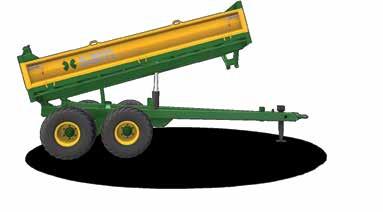

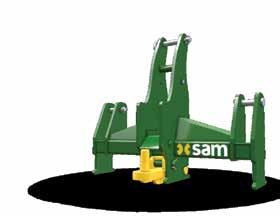

• The zero-effect assessed for methane would reduce NZ’s total emissions by 30+%; huge cost savings for NZ, and the rest of the world.
The contention that climate policy is “science based” is simply not true.
With about $200 million already spent on R & D with little to show for it, the chances a further $350 million for new research will produce
solutions don’t appear too hopeful.
The new metric GWP* is based on very dubious science, but it is not suitable for “on farm” measurement of methane required under HWEN. It could be used for an industry-based approach, which would not require individual on-farm measurement. I would get rid of the immense and expensive bureaucracy and consulting overview required, a huge burden for industry.
Much is made of the split gas approach now enshrined in legislation, which treats methane separately from CO2. With no effect for methane, this is logical.
CO2 is touted as a
long-lived gas, much of which is hyped to stay in the atmosphere for centuries to thousands of years. It is not a longlived gas at all.
The half-life of CO2 is 10 years only. Just how we got to industry commentators saying human CO2 virtually stays in the atmosphere for ever is anyone’s guess.
As John Maynard Keynes said: “If the facts change, I change my mind, what do you do sir”?
Wouldn’t it be a good idea if all the parties could talk to each other for the industry and NZ’s benefit?
• Dr Jock Allison. ONZM, FNZIPIM is a former head of AgResearch Invermay

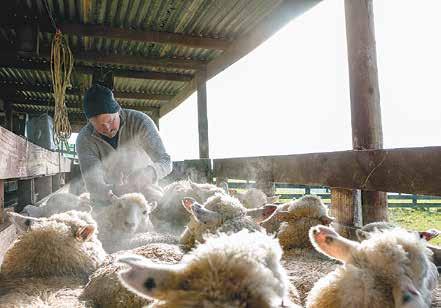
ANIMAL DISEASES are associated with significant increases in livestock greenhouse gas emissions, land use and reduced productivity.
In addition, they pose a threat to food security. Animals suffer from various diseases, some of
which can be fatal. Even non-fatal diseases have detrimental effects on animal welfare, productivity, and the livelihood of farmers. For instance, a cow that is ill may experience reduced milk production or become unsafe for meat consumption. This results in constrained supply chains,
potential shortages for consumers and, wasted investment and lost earnings for the farmer.
On the other hand, well-managed livestock can be expected to live longer, healthier lives – making them more productive and environmentally sustainable. Innovation in veterinary
care has proven successful in improving the survival rates of livestock, which improves farmer returns and reduces greenhouse gas emissions. Taking preventative measures such as vaccinating or deworming offers greater productivity, which leads to higher farm incomes and more
GREG PETERSON, WIDELY KNOWN AS “MACHINERY PETE,” HAS BEEN RESEARCHING AND TRACKING MACHINERY AUCTION PRICES SINCE 1989. WITH MORE THAN 25 YEARS OF EXPERIENCE IN THE MACHINERY BUSINESS, MACHINERY PETE TV TAKES YOU INSIDE THE INDUSTRY, WITH FARMERS AND DEALERS, PROVIDING A COMPREHENSIVE LOOK AT USED FARM EQUIPMENT.

NZ PREMIERE
WEDNESDAY 7 @ 8.00PM
DECIDING IT WAS TIME TO TURN UP THE HEAT, STEVEN RAICHLEN INTRODUCES HIS HOTTEST SERIES YET, PROJECT FIRE, A NEW AND INSIGHTFUL EXPLORATION OF HOW WE GRILL TODAY AND HOW WE WILL GRILL AND SMOKE TOMORROW.
NZ PREMIERE
SATURDAY 3 @ 9.00PM


PERLEY’S PLACE IS CLASSIC COUNTRY MUSIC FROM BEGINNING TO END. STARRING AWARD-WINNING ARTIST PERLEY CURTIS, ANYONE WHO ENJOYS THE CLASSIC SOUND OF REAL COUNTRY MUSIC WILL LOVE ‘PERLEY’S PLACE’.



food availability for consumers.
A report by Oxford Analytica, commissioned by HealthforAnimals, provides a clear picture on the economic returns of taking preventative measures. Through better adoption of existing best practices and technologies, The Animal Health and Sustainability: a Global Data Analysis report, calculates that livestock could comfortably serve a world population of 9.8 billion by 2050 without increasing current emission levels.
This reduced emissions intensity means livestock could meet the protein needs of an additional 1.6 billion people without increasing livestock’s overall GHG emissions level.
The findings are corroborated by other sources such as the Food and Agriculture Organization (FAO) of the United Nations, which estimates that ‘advanced genetics, feeding systems, animal health controls and other technologies over the past four decades allowed industrialised countries to reduce their overall land requirements for livestock by 20% while
With climate change rising in importance globally, finding ways to limit and reduce the environmental footprint of animals in agriculture while continuing to feed a growing population will be a top priority.
doubling meat production’.
With climate change rising in importance globally, finding ways to limit and reduce the environmental footprint of animals in agriculture while continuing to feed a growing population will be a top priority.
Improving animal health can increase livestock productivity and limit emissions.
The FAO estimates that livestock GHG emissions could be reduced by 18-30% by expanding use of existing best practices and technologies in animal health and husbandry.
Food insecurity will continue to be a major issue for the foreseeable future. Food insecurity is defined as the lack of access to an adequate quality and quan-
tity of nutritious food, and stems from inadequate incomes and high living costs.
Proper management of livestock can play an important role in addressing the world’s food needs. If herds are not properly managed, the loss of food output reduces the supply of food and the complete proteins and micronutrients available to people.
Increasingly we will need to turn to animal health technologies for the health of people, animals, and the environment.
• Mark Ross is chief executive Animal and Plant Health NZ, which represents the New Zealand animal health and crop protection industries as well as rural retailers. The association was formerly called Agcarm.



THE MINISTRY for the Environment (MfE) recently released a report on the state of New Zealand freshwater (“Our Fresh Water 2023”).
I read it from the perspective of a farmer, who enthusiastically joined the local catchment group focused on improving water quality. What information, I asked myself, would such a farmer expect to see, or wish to see in such a report?
The 2023 report begins cautiously:
“Many of the issues identified by the Parliamentary Commissioner of the Environment in his 2019 system review still challenge current reporting. These issues are evident in the content of Our Freshwater 2023: there continues to be gaps in data, inconsistencies in methods and monitoring, lack of accessibility…”
So, what did the Parliamentary Commissioner of the Environment (PCE) have to say in 2019?

“Despite attempts over more than two decades, no agreement has ever been reached on a set of core environmental indicators. This has to happen. Consistent and authoritative time series coupled with improved spatial coverage are essential if we are to detect trends. Only then will we be able to judge confidently whether we are making progress or going backwards.” He was also critical of the ability of reporting agencies like MfE to “prioritise and interpret the data and research they commission.”
This 2023 report by MfE was preceded by a similar report in 2020 (Fresh Water 2020). This report was torn to shreds by Federated Farmers. Their summary says it all: “Notwithstanding the breadth and depth of data available to support national reporting and pressure-state-impact analysis, FW2020 falls
well short of being a robust and authoritative source of national statistics and apolitical interpretive analysis. Instead FW2020 presents headlines which are not supported by the evidence relied on; it highlights minority findings, but not the majority findings; it fails to engage with the depth of data available and presents only ‘selected’ and misleading statistics and graphics.”
The effect of this… “was to significantly distort public and political understanding of national state and trends.”
Given this background what improvements have been made in this latest 2023 report?

Firstly, it is mostly narrative: To the casual reader it is a bunch of stories about the environment, presented with little hard data or evidence. In other words, a bunch of meaningless aphorisms like: “Evidence shows the health of freshwater ecosystems around Aotearoa are variable. Some places and measures got better and others go worse.”
And: “Land-based human activities contribute to excess nutrients and sediments in our fresh water.”
Collectively, such statements, and there are many of them in the report, give the impression that all is not well. Further, while they may contain a grain of truth, they are not very useful to my farmer and his catchment group who want to know whether their efforts; riparian planting, restoring wetlands or fencing off waterways, are having any effect on water quality.
My farmer will be dis-

appointed to learn in the section “Data and Research Gaps” that we need a better understanding of “…..how quickly our freshwater ecosystems are changing in response to pressures, and how resilient they are to the ongoing effects of our activities.” And that “The Ministry for the Environment in conjunction with sector partners, are embarking on a significant programme of work to reform the foundations of the system. This will include developing core indicators for monitoring our environment, designing the analytical architecture required to assess and interpret the data, and the blueprint design of a national monitoring network.”
So, while my farmer and his catchment group have been doing the “hard yards” the bureaucrats in Wellington are still procrastinating about what they should do!!! Despite the forewarning of the PCE, in 2019, this does not sound like progress to me!
I decided to dig a little further.
Behind both the 2020 and 2023 MfE reports there are large datasets complied by Statistics NZ, which mainly come from regional councils and NIWA. These cover a wide range of factors which affect water quality. I homed in on two river quality indicators, which I thought my farmer would like to know about: the trends in nitrogen and phosphorous. We learn that the 20 year trends up to 2020 are: for P (77% improving, 14% worsening, and 10% indeterminate) and for N (41% improving, 51% worse and 9% indeterminate). At last, a few specs of gold!
It seems to me that these data reflect what has been happening on farms in the last 20 years. Catchment groups, fencing of rivers, riparian planting, wetland restoration – all of these things reduce P runoff and hence the loading into
waterways. My farmer would be encouraged to know that things are improving.
Nitrogen (N) is a more difficult beast to tame. N leaches down



through the soil and reducing this requires either reducing the N concentration in urine or the number of urination per unit area. Research is underway in this space
but in the meantime some farmers have ‘bitten the bullet’ and reduced stock numbers. In any case the trends in N do not spell disaster.
Why was this data not
highlighted in the 2023 report?
We are back to the criticism, made by Federated Farmers of the FW 2020 report, that it was biased, the effect of which… “was to significantly distort public and political understanding of national state and trends.”
So, there you have it Mr Farmer. Keep doing all those good things as per your catchment group and for heaven’s sake allow time for Wellington to catch up!
• Doug Edmeades spent 20 years as a MAF soil scientist at Ruakura and in 1997 established his own science consulting business agKnowledge.


ALLIANCE GROUP
says it has invested in new technology designed to measure the level of intramuscular fat in its beef and lamb to help capture greater product value.

In what is believed to be a first for a New Zealand red meat company, Alliance has been trialling Fluorescence Spectroscopy technology at its plants at Smithfield (Timaru) and Pukeuri (Oamaru). The technology aims to consistently identify premium quality marbled beef and lamb with high intramuscular fat (IMF). Fluorescence Spectroscopy technology uses light to accurately measure IMF in a carcass at commencement of processing to capture a ‘fingerprint’ of the IMF within a loin muscle.
The company says the
two largest contributors to the sensory experience when eating quality meat are IMF and ageing, with higher levels of IMF believed to be the greatest contributor.
“One of the challenges we have as a food company is to create the highest quality taste experience 100 per cent of the time,” says Willie Wiese, chief executive of Alliance Group.
“We have been working on this project for the last 12 months. This technology is exciting because we can immediately identify all premium quality
carcasses early on without disrupting production and optimise the opportunity for higher returns in our global markets.

“It will enable us to build up and scale our premium programmes, which is a growing part of our business.”
Alliance Group partnered with High Health Alliance (its joint venture with Headwaters) in conjunction with the Ministry for Primary Industries to successfully deliver the technology.
Wiese says another key benefit is the ability to use the data to provide
a detailed breakdown of a farmer’s mob performance over the entire season.
“This will allow the
farmer to drive behind the farm gate improvements to their stock and land.”
General manager sales
and marketing Shane
Kingston says taste and texture are the number one drivers of a consumer’s eating experience.
He believes with the use of evidence-based markers, Alliance Group can further differentiate its product offering to target consumers.
“High IMF levels represent the healthy fats which are good for nutrition but also the health of the animal. It is therefore a key attribute that needs to be measured by livestock unit whilst other contributors can be periodically measured.”
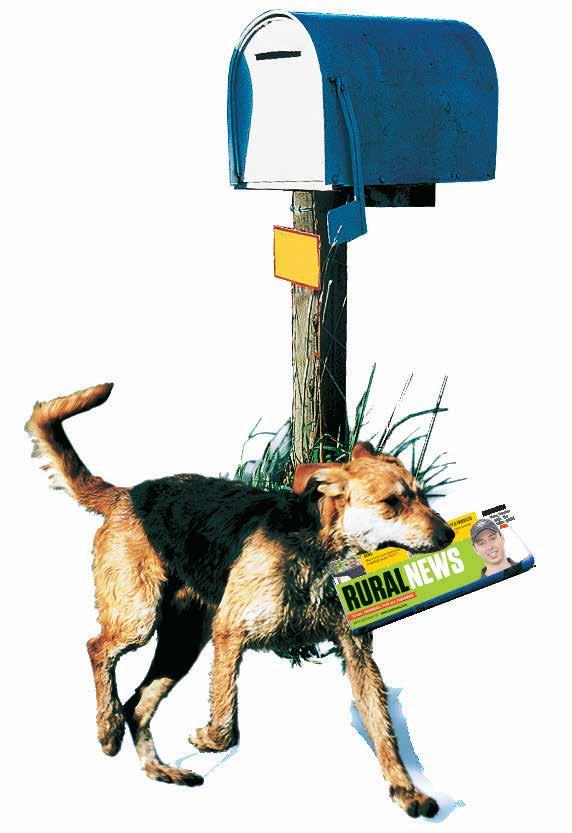
He says the technology can help drive accuracy and efficiency across Alliance’s premium lamb and beef brands, ensuring consumers’ taste experience is consistently high.
Kingston adds that the company hopes to use the technology for its premium lamb and beef brands, Lumina Lamb, Handpicked Lamb, Handpicked Beef, and Silere.
“One of the challenges we have as a food company is to create the highest quality taste experience 100 per cent of the time.”
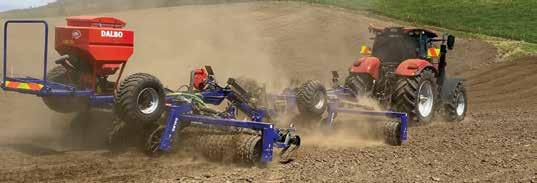


ALL SHEEP, beef and deer farming operations should consider joining the New Zealand Farm Assurance Programme (NZFAP).
That’s according to New Zealand Farm Assurance Incorporated chair Nick Beeby, on a recent RaboTalk podcast. He says the NZFAP – originally set up with the aim of reducing duplication and cost for farmers and providing assurance to global consumers that New Zealand meat and wool is authentic and safe – had evolved in recent years and is now increasingly easy for farmers to get involved.
NZFAP covers numerous farms and processors, with a voluntary higher level sustainability programme, NZFAP+,
launched in 2021, with a 2022 review building on farmer feedback to add a tiered approach encouraging uptake and continuous improvements.

Beeby says that silver tier was about identifying key resources on farm and putting foundational steps in place around developing farm and natural resource plans. Meanwhile, the gold level was about implementing that plan and the ongoing monitoring of it along with more aspirational requirements. He encourages farmers to ‘make the first step’ and get involved, while saying that accreditation schemes are not going away.
“Whether it be around proving our animal welfare credentials, or improving our environment and sustainability
credentials, this is big for our industry.
“Farmers are doing the right things on their farm, and this step (NZFAP accreditation) is about
proving or verifying that they’re doing the right thing and having that independently audited so farmers can stand behind what they are doing.”
In addition to verification of on-farm activities, the programme is now being used by many farmers as a genuine farm business planning tool.
B+LNZ SAYS while the 1 May application date has passed for farmers requiring a resource consent to graze their winter forage crops this year, it’s not too late to put together a wintering plan.
Under the new Intensive Winter Grazing regulations, farmers whose wintering practices do not meet the permitted activity criteria need a resource consent, and applications for these were due by 1 May.
Heather McKay, Beef + Lamb New Zealand’s environment policy manager, suggests that anyone who might have missed the deadline, or is unsure of their responsibilities, can still contact their regional council.
“This is the first year of these new rules and councils have indicated they are taking an educative approach to implementation. They have staff who understand what is required and who will support farmers as they work
through their regulatory requirements.”
Mackay is encouraging all farmers grazing forage crops this winter to put together a wintering plan before the onset of the cold weather.
This plan will help identify any risks to either the environment or animal welfare associated with intensive winter grazing and allow strategies to be put in place to mitigate them. Winter plans also help ensure
The NZFAP+ programme builds on the existing NZFAP, including additional topics which have seen increasing customer enquiry in recent years like people management, farm and natural resources and biosecurity, along with room for expansion in future as new standards come in.
Beeby added that his own farming operation is currently going through NZFAP+ process accreditation and this has highlighted many benefits of programme participation.
“I’d like to think that I know our farm better than anyone, but as we went through the farm planning process, there were a huge number of little things that I picked up on,” he explained.
“Like identifying the critical source areas within paddocks and using that
the whole farm team knows what is required of them as they manage these crops over the winter months.
She says anecdotal reports from regional councils confirm that wintering practices have improved significantly in recent years, and she is encouraging farmers to carry on the great work by putting plans in place that protect soil and water resources while ensuring livestock is well-fed and comfortable.
as a way of paddock design; new knowledge to me that will certainly assist with our farm business. It’s been really beneficial going through it.”
Beeby said increased digitisation of the programme was one of the big priorities in 2023, with NZFAP online set to launch later this year providing farmers with the ability to record evidence through their phone and also looking at integration with other providers to avoid duplication.

“If farmers are recording a lot of their evidence online, auditors can assess a lot of that before they come onto the farm. So, when those auditors are on the farm, they’re not having to rummage through the shoe box of receipts and they can spend their time on more valuable things.”
“B+LNZ has winter plan templates available which makes the process very simple. Farmers know their farms better than anyone; they know where critical source areas are and which paddocks are more vulnerable in wet weather.
“The planning template taps into this knowledge and ensures that practices are documented if ever proof was required to meet regulatory or market requirements.”
AI IS being used to report on samples with high parasite counts ensuring farmers with high FECs (faecal egg counts) receive results within minutes.
Faecal samples processed through FECPAKG2 are analysed utilising the speed and power of AI and when results are high – more than 700epg in sheep and horses – a preliminary FEC result is reported within a few minutes. This is followed a short time later with a confirmed count from this new technology.
Techion – the company behind this new technology – believes this innovation will help farmers make faster decisions for animals requiring immediate parasite treatment.
“We hope provid-
ing near-instant FEC results when testing using FECPAKG2 will encourage more farmers to test more often,” says Techion founder and managing director Greg Mirams.
“The ability to make fast informed decisions is an important development for farmers managing the welfare and performance of their livestock. We process tens of thousands of FEC tests annually from farms across New Zealand and we are recording increased variability of results and at times, higher parasite challenges than in previous years.”
Mirams says the double whammy of climate change and increasing drench resistance means the usual pattern of the parasite challenge, which farmers have tra-


ditionally observed, is changing.
“This means regular FEC testing is a crucial aspect in effectively managing parasites throughout the year.”
He adds that initiat-
ing fast AI generated FEC results for high tests was the first step in the company’s AI development.
Techion, the developer of parasite testing platform FECPAKG2, has partnered with AI devel-
opers Aware Group to create the automated FEC result reporting technology. The more tests which run through the AI model over the coming months the higher its accuracy will
become.
This will enable instant AI generated results for all tests for all production animals in the future.
FECPAKG2 is an onfarm parasite manage-
ment system which processes FEC tests for sheep, equine, cattle and camelids, securely storing results. Its portable digital microscope – the Micro-I – takes photos of faecal samples and immediately sends the images to the cloud for analysis by AI and/or trained technicians.

The FEC results are securely stored on the platform, can be reviewed and can be used to understand which animals are at risk and which paddocks are parasite hot spots. All FEC results from FECPAKG2 are emailed to farmers and can be shared with approved advisors – such as vets –allowing them to make informed treatment decisions.

@rural_news
facebook com/ruralnews

“We finished our calves at weight one month earlier, with nearly zero wasted meal.”










































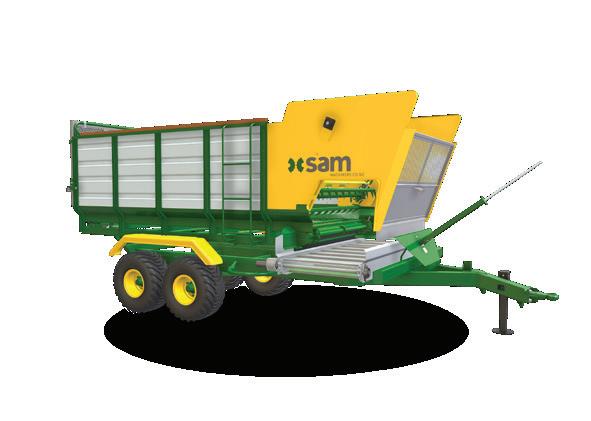
































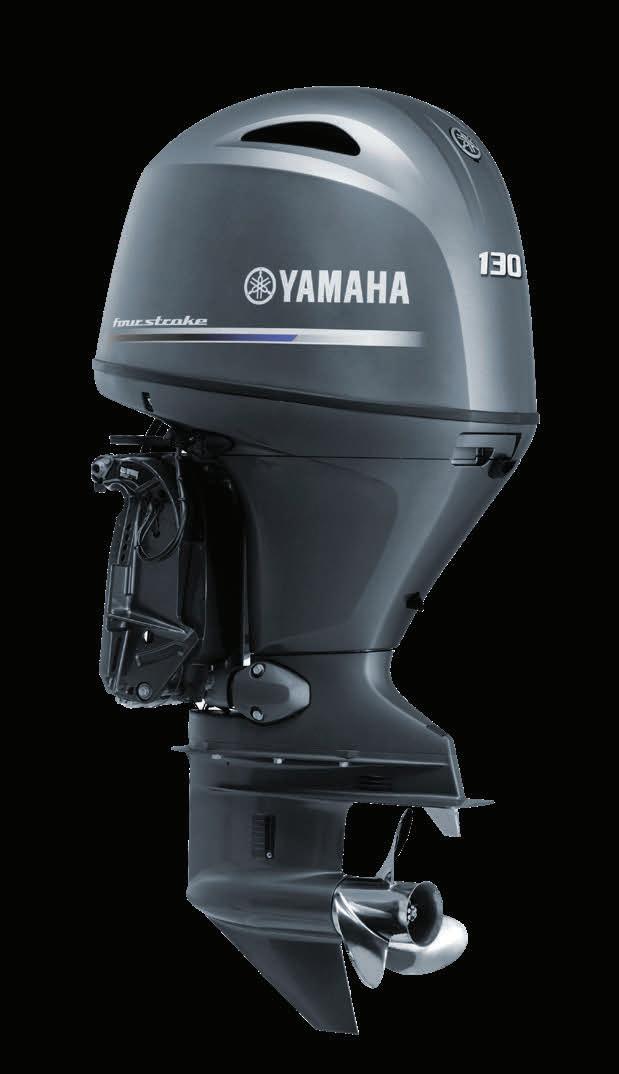


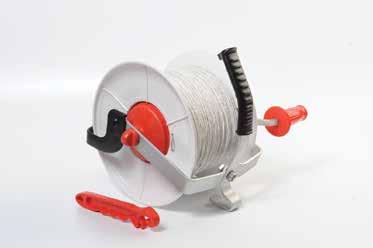


MASSEY UNIVERSITY
will be celebrating its 50th anniversary of holding a site at the National Fieldays this year.

Like previous years, Massey staff will be sharing leading research, innovation and teaching with visitors.
Collaborators from the School of Agriculture and Environment’s Farmed Landscapes Research Centre will present a working farm model made up of two contrasting agricultural landscapes. The model will exemplify a series of Best Management Practices (BMPs) to help improve and manage water quality within agricultural systems.



A team of senior academic and teaching staff will walk attendees through the working model to showcase key findings from the school’s research and how the adoption of BMPs can lead to improved environmental outcomes.
Head of School of Agriculture and Environment Professor Paul Kenyon is excited about the opportunity to share research he says can significantly improve the impact of farming and help protect the surrounding environment for a more sustainable future in the agricultural sector.
“The model will show-


case BMPs across a representation of the country’s diverse farming environments to illustrate the right mitigation measures in the right place. Putting these practices into play can make a huge improvement to the water quality in our rivers and help alleviate the effect of farming on climate change.”
One area of the model will represent intensive farms on flat, high-producing soils and showcase research into the benefits of plantain as well as variable rate irrigation.
The other area will depict more extensive production systems on hill country, showing a buffer zone at the bottom of the slopes and a detainment bund to capture contaminants.
Bachelor of Food Technology alumna Margie Hunt will be joining the stand to show-
case her company Soochi, which merges the science of nature, taste and innovation to produce a range of wellness drinks and supplements.
Sustainability has been a driving force behind the brand’s ethos, particularly when it comes to sourcing collagen which provides benefits for skin, hair and nails.
“Collagen can be a contentious topic and not all collagen is created equal, so we’ve put a lot of work into making sure we source ethically and for efficacy. The collagen peptides we use are a hydrolysed, easily absorbable form of collagen which is a by-product of meat production. As someone from a farming background, I’m a huge fan of zero waste when it comes to animals and believe that finding ways to use all an animal is a way to respect the life

that gave to us,” Hunt says.
Along with chief executive Tina Chou and creative director Naz Babapour, the all-female founding team have a shared mission to create innovative collagen and prebiotic sodas and supplements they say are good for the skin, body and mind while also being kinder to the environment.
The concept of the collagen drink was initially part of a food design and development project when Hunt was a student at Massey. After graduating she revisited the idea and continued development with Chou and Babapour to produce an improved drink with a gut health element that doesn’t compromise on taste. Hunt says her food technology degree provided a lot of practical knowledge and skills that have been foundational in
her career. “A lot of what I learned in my fourth year about product development has really helped me get here.
“The Massey degree not only gave me knowledge and skills to apply in my business, but offered networking opportunities
and the chance to speak with experts in the industry.”

The Soochi team will be offering tastings of their drink range at the Massey stand and the opportunity to chat about food technology and product development.
Visitors will also have the chance to take home a canned drink with a flavour of their choosing.
Hunt will also be joining the Wāhine toa o te Whenua: Future of Food and Food Tech panel discussion on Thursday 15 June at 11:30am.





THE FIELDAYS Forestry Hub will again feature at Mystery Creek in Waikato.

Like last year, the Fieldays Forestry Hub, located at site G80, will host about twenty sector organisations under the theme of ‘Wood our lowcarbon future’, with staff from large companies and small not-for-profit agencies on hand to provide information and answer questions.
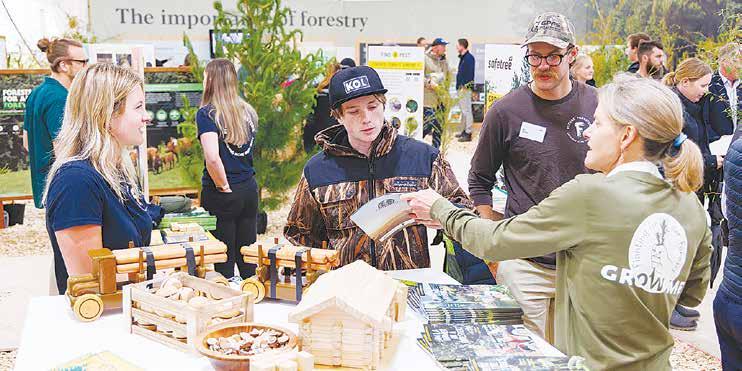
A new series of forums and talks is planned for visitors wanting to know more about the forestry and wood processing sector. The Hub will host two forums and several ‘hot-topic’ talks that will be open to the public,
with time scheduled for questions and answers.
Other attractions include a forestry simulator, so visitors can experience what it’s like to operate machinery in a forest, and a couple of large forestry machines to view close-up. Forestry Minister Peeni Henare has been invited to officially launch the Hub for 2023 on Wednesday 14 June at 11:00am. The Hub is a collaboration between Fieldays and an advisory group comprising New Zealand Forest Service, Forest Growers Levy Trust, Scion, NZ Forest Owners’ Association, Red Stag, NZ Farm Forestry Association and Future Foresters.
Hub spokesperson
Alex Wilson says the sector has begun a process of transformation in partnership with the Government with, most recently, the launch of a $57 million Wood Processing Grant Fund in April and the release of the foundational Industry Transformation Plan (ITP) last November.

“The sector can expect more information on the ITP projects to be released at Fieldays.

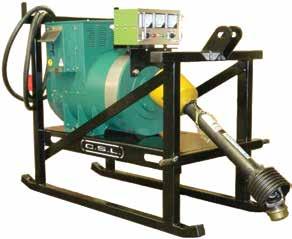



“The wider public can anticipate an engaging experience on the possibilities of trees and wood as the sector helps to mitigate climate change and addresses the challenges of wetter and hotter weather in many parts of the country.
“The forestry and wood processing sector is New Zealand’s fourth largest primary industry exporter and a major contributor to regional economies and employment.

“Fieldays gives our sector a particular opportunity to have conversations with rural landowners about the opportunities to grow trees for timber, protect the land and to store carbon.”
New Zealand Farm Forestry Association president Neil Cullen says many farming organisations agree that an integrated tree planting approach on-farm is the best way forward to address the

many environmental land use issues.
“The Farm Forestry Association will have a significant presence in the Fieldays Forestry Hub to explain how its members have practically implemented this approach, and which tree species work best and what are the costs and returns.”
New Zealand Forest Owners’ Association president Grant Dodson says the Forest Hub is a valued way the industry can communicate directly with farmers and the public.
“We’ll be there to explain the truth of some issues, such as the many things we are doing to reduce forest waste, but
also just to communicate that we have a lot more in common with the rest of the primary sector than many people think.”
Scion chief executive Dr Julian Elder says Scion’s 2030 Strategy of right tree, right place, right purpose is highly relevant for rural New Zealand.
He says future rural landscapes and communities would include a mix of farming, productive forestry, trees and new manufacturing and processing activities.
Full details about the Fieldays Forestry Hub can be found at https://www. fieldays.co.nz/attendfieldays/explore/forestry.
@rural_news facebook com/ruralnews




PRIMARY SECTOR education and exciting career opportunities will be showcased at the Fieldays Opportunity Grows Here Careers Hub next month.
Fieldays and the Ministry for Primary Industries (MPI) are hosting the hub to provide a platform for students, job seekers, and industry professionals to connect and learn more about the many different career pathways available in the
est agricultural event in the Southern Hemisphere, and a key focus is on building awareness of education opportunities available and all of the terrific careers available in our food and fibre sector,” he says.
“We are thrilled to partner with MPI to promote education and get young people excited about a career in ag.
“Education is one of Fieldays’ strategic pillars,
range from work on-farm, in science, technology, business management, and logistics, to animal welfare, marketing, and research.

food and fibre sector.
“We’re proud to be working with Fieldays to deliver this exciting Hub for the second year running,” says Ray Smith, Director-General of MPI.
“Our food and fibre sector continues to power New Zealand’s economy, with export revenue hitting more than $53 billion last year.”
Food and fibre sector careers range from work on-farm, in science, technology, business management, and logistics, to animal welfare, marketing, and research and development across the country.
Smith says another new programme will be a series of inspiring speakers each day from 9.30am-2pm, featuring panel discussions and TED talk type presentations, showcasing the sector, the roles, and various opportunities.
“Eleven organisations with a keen focus on future growth and education will also be featured in the Hub.

“The Hub builds on the success of our Opportunity Grows Here attraction campaign that’s connecting Kiwis with sector jobs.”
Fieldays chief executive Peter Nation says it places a huge importance on education.
“Fieldays is the larg-



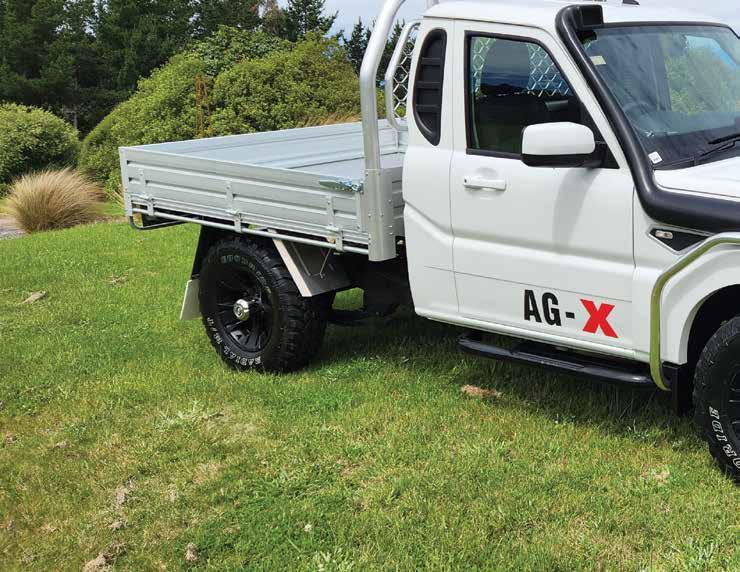
Hub and a full programme of the Engagement Sessions and Panel Discussions during Fieldays, please go to https:// www.fieldays.co.nz/

attend-fieldays/explore/ careers. Download the Fieldays App to access the Fieldays Opportunity Grows Here Careers Trail.
and this Hub provides an excellent platform for learning from and connecting with those who work in the food and fibre sector.
“There’s a huge amount of opportunity here in New Zealand, and the future of the sector is exciting. Innovation and the evolving ways of farming means there will be new jobs and new possibilities in the future.”
In addition to the Hub, the Opportunity Grows Here Careers Trail will provide visitors with an interactive experience to see career pathway opportunities and engage with potential employers.
“Creating the pathway for visitors to learn about the many different career opportunities available in the sector, from hands-on roles in agriculture and horticulture, to technical roles in science and technology, really does prove that opportunity grows here at Fieldays,” says Nation.
“To ensure the success of our food and fibre sector, we need the right people. Our Careers Trail will be a valuable resource for our visitors and sector employers by creating important, and potentially life-long, careers and connections.”
For more information on the Fieldays Opportunity Grows Here Careers
Food and fibre sector careersThe Career Hub provides a platform for students, job seekers, and industry professionals to connect and learn more about the many jobs available in the food and fibre sector.
THE HUMBLE muckspreader has evolved into the technological age, with UK-built Bunning rear discharge spreaders offering a range of options to suit today’s precision farming requirements.
For exceptional accuracy of application, the Topcon ISOCAN variable rate controller features live 20 tonne weigh-cells positioned on the spreader chassis and drawbar. This allows the operator can see the exact weight in the machine, and that of the product that has already been spread.
Forward speed is monitored via a GPS receiver, while working width is entered by the operator, although usually governed by the type and consistency of the material being spread. From this point, the operator enters a target spreading rate in tonnes per hectare, from where the computer will vary the spreader floor speed to achieve the desired application rate.
The control system can be via a supplied RDS Topcon monitor, or a tractor’s own ISOBUS screen. If section control is unlocked on the tractor, the spreader is also able to switch itself off, should the tractor
travel across an area that already has been spread.
For those wanting to undertake precision farming with variable application rates, a pre-defined

Your Farm Water Data With:

• Tailored Presentation
• Real Time Data
• Action Alerts
• Mobile Friendly
• Environmental reporting
• Meter Verification
• Blue Tick accreditation
• Clean water setup
application map can be loaded via a USB connection. Data can be logged and exported via USB and can be viewed as an Excel spreadsheet.
Hastings-based Bostock New Zealand purchased a Bunning Lowlander 150 wide-body model featuring twin, large diameter vertical
augers combined with large spinner discs. The machine also features a removable rear canopy which ensures wide and even spread of fine mate-
We connect your data to give a real basis to use water
• Correct irrigation
• Tank and pond levels
• Soil moisture
• Climate station
Clients use us because
• Good Value... cost effective data
• Easy setup and easy to use
• Uncomplicated presentation giving simple farm management decisions
• Saves staff time
• We have nationwide service and backup
rial such as chicken litter, but it can also be removed to deal with heavy, wet material such as drain cleanings.
Bostock’s Andrew Meulli says they are very satisfied with the performance of the new muck spreader. “It has massively increased our productivity and efficiency within our spreading program.
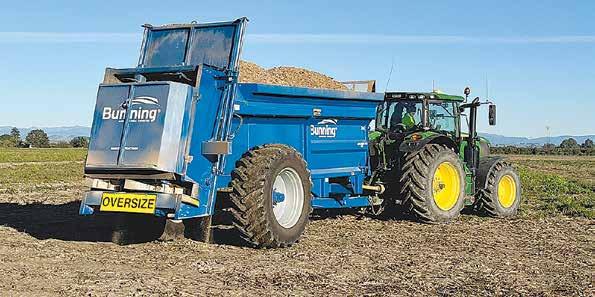
“The spread rate is relatively accurate across our range from 5 t/ha to 20 t /ha and across 3 different products. Downtime has only been one shear-bolt and a loader tractor window to report at this stage.”
@rural_news
facebook com/ruralnews
• We are well established being the leading provider of water measuring systems

• Reliable leading global equipment
• Industry expertise designed for and by agri people

MOTHER NATURE
always has a part to play at harvest, so after inter-
mittent showers on already wet fields made it a challenging period at Crystal Brook, in South Australia’s Mid North, David Hosking was keen
to see how quickly his new John Deere X9 1000 combine harvester could get through the workload.
“On one decent hot day on the X9, we har-
vested nearly 600t of wheat over a 12-hour period, with two of us delivering nine or ten road trains for the day,” Hosking said from his base at Narridy.
“It was so wet in September, October, and November that the water was still running out of the ground, and a late start meant we finished harvest a month later than usual.
“But despite the 2022 cropping year being bookended by a dry start and a wet and windy finish, it was a good harvest, and one where the X9 proved its worth in the paddock.”

The Hoskings’ drysown crops - 550ha of bread wheat, 210ha of durum, 790ha barley, 100ha of faba beans and 1150ha of lentils, recorded above average yields.
“We averaged over five tonnes per ha for wheat and over three tonnes per ha on the lentils. Overall, we put as much grain through the X9 Harvester in one harvest as we have in the past two-and-ahalf years, thanks to the good yields and expanded cropping area,” Hosking said.
After expanding land area under cropping to 2800ha in 2022, the Hosking family replaced their John Deere S680 and 45-foot front with the X9 Harvester featuring a 50-foot hinged draper front, to get their crop off and away quickly. The X Series machine effectively offered an extra half a header in power and capacity but in the same frame size as the S Series.

With weather conditions becoming more variable, the X Series is
designed to optimise harvest windows and enable farmers to harvest quickly and with minimal grain loss. Hosking said the new machine handled a variety of operating conditions with ease, with the biggest surprise being fuel economy, during the 350 threshing hours.

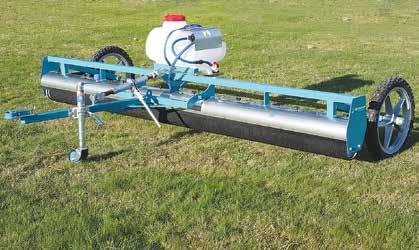
“Although we were harvesting 60 to 70% more tonnes per hour than in the S680, we used the same amount of fuel.

“We’d expected to use 100L per hour, but averaged 80L per hour, across the campaign” he said. “Although we didn’t need to upgrade our fuel trailer, following a demo, we knew our chaser bin wouldn’t keep up, so we invested in a bigger bin, upgrading from 18 tonnes to 36 tonnes.”
Nervous about how the X9 Harvester’s hinged

draper front would handle the challenge of some rocky conditions and the deep wheel ruts made in the wet, he was “very impressed” by its performance.
“It was far superior to anything we’ve ever harvested with or seen in cereals. The front tracked the ground very well and the draper system was able to feed in cereals very smoothly,” he said.
“We harvested a lot of lentils on the ground with wheel tracks which was challenging, but the number of settings was very good.
“The ability to change knife angles and downforce settings from the cabin, as opposed to getting out to do it manually, was useful and appreciated by the operators.”
@rural_news
facebook com/ruralnews


IT’S THAT time again to break out the gumboots and a warm coat for the National Fieldays, which for 2023, returns to its normal mid-winter timeslot.
This follows the 2022 event, held in late November/early December, that failed to hit the mark with many exhibitors and had about half the usual numbers through the gate.
With around 1000 sites already committed to by enthusiastic exhibitors, National Fieldays chief executive Peter Nation reports that it appears that some of those exhibitors are making major investments in their displays.
Nation also notes that alongside absentees from previous events, like Toyota NZ, AGCO and Claas Harvest Centres who are returning, some new names like Synlait, NZ Wagyu and The Italian Trade Association have taken space for the first time.




Nation and head of customer and strategic engagement, Taryn Storey, point out that a change of the traditional layout has opened the site for “core business” that in practice sees the increasingly popular Rural Living and Outdoor areas moved to the east of the
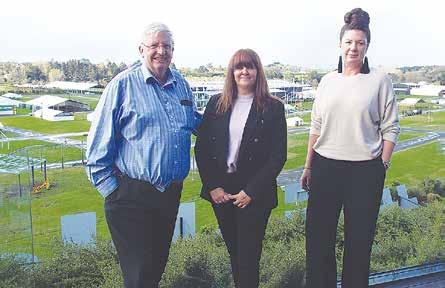
Main Pavilion and adjacent to the neighbouring Tieke Golf Course, while the majority of the agricultural machinery sites have move to the southwestern side of the showgrounds.
Nation says, “The move has been welcomed by most of the machinery exhibitors as it delivers a larger area of flat sites and the benefit of an adjacent refreshment area.”




Alongside the wellestablished Innovations, Health and Well Being, Forestry and Careers Hubs, a new Sustainability Hub has been introduced, following four years of planning and collaboration with The Environmental Protection Agency. The ‘core’ issues being addressed will be Water, Electricity and Waste, with multiple exhibitors hopefully able to provide information and solutions regarding current and emerging best practice to help protect our environment.
In the Careers Hub there are already commitments to visit from 38 schools, from as far as Geraldine High School in the South Island, with around 1200 students expected to learn about pathways to a career in rural employment and the associated professions, while also keeping an eye out for opportunities on the Live Job Board.
Nation suggests that in its 55th year, the event will “offer rural folk the chance to come and see the latest or emerging technologies and practices, but even more

importantly, a chance to get away from the farm for a few hours or a day to catch up with a few mates.”
up to 30%.
INDUSTRY RESEARCH
has shown that on average tractors spend up to 70% of their time on haulage duties.
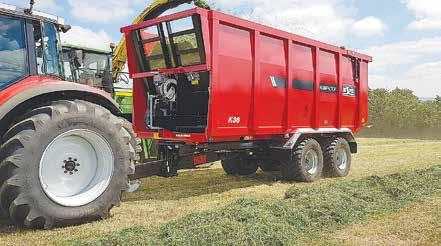
It would make sense then that the loads they tow would benefit from an increase in density to reduce the overall number of trips required, thereby increasing efficiency.
Irish company Hispec has adopted this thinking with its Kompactor trailer range, embracing the principles being rapidly adopted by the freight transport industry, with a system that can increase trailer loads by
Available in New Zealand, the tandem-axle K36 trailer features a 22-foot long body offering, a 36 cubic metre capacity, carried on a heavy-duty chassis that uses high-speed commercial running gear and super single tyres. Standard specification also includes air over hydraulic braking, a hydraulically sprung drawbar and bolt on swivel ring hitch.
Using a steel body construction, extensive vertical bracing helps retain rigidity to overcome any compaction loadings, while at the same time delivering an extended working life. At the heart of the system,
compaction is achieved by a multi-stage hydraulic ram that moves the floor/ headboard rearwards to firstly compact, then eventually discharge the load. The company notes that the moving floor serves to carry the load



and reduce the overall pressure on the moving headboard.
Material is loaded by harvester or loaders, starting at the rear and moving forwards. During the loading cycle the tractor driver has visibility of
the load via a large vision panel integrated into the front bulkhead. Compaction can be initiated during the loading process, or during headland turns when used for harvesting operations.
At the rear of the
machine, the tailgate is secured using a drop and lock system to resist the compaction forces.

After any compaction sequence, the floor and headboard return to the start position at the front of the trailer.
Unloading, using a moveable headboard for ejection, is said to offer several benefits including the ability to discharge in low headroom situations, increased stability by removing the need to tip long bodies at steep angles and the removal of vertical jack-knife situations caused by “sticking” loads.
In operation, the rear door raises to 90 degrees from the closed posi-
tion to clear the trailer body, so allowing an unimpeded discharge in around one minute. Attention to detail see the headboard stopping flush with the rear edge of the trailer body, ensuring complete discharge of any material. Other details at the rear see a discharge chute incorporate into the floor to allow controlled discharge of free running materials.
A range of options includes a passive rear steering system for the K36, allowing tighter turning and a lock-out system for reversing. www.gaz.co.nz

@rural_news facebook

CNH INDUSTRIAL and One Smart Spray, the joint venture between Bosch and BASF, have signed a collaboration agreement to integrate the latter’s advanced spraying system within CNH Industrial’s agricultural brand product portfolios.
The system’s integration will be led by the Raven team and will be commercially available via the global Case IH and New Holland Agriculture brands.



The One Smart Spray integration offers an important solution that will fast track CNH Industrial’s precision and automated spraying capabilities, using multiple cameras installed on a sprayer’s boom to provide customers with green-on-green (plant on plant) and green-on-brown (plant on soil) weed detection and selective spraying.

Precision is combined with digital tools and agronomic insights that are accessible via mobile devices to provide in-depth weed maps, track input and cost savings in real time and generate automated reports and data. These deliver farmers clean fields while max-
imising herbicide savings, operational efficiency and sustainability. The system also allows farmers to set up their desired spraying operations both
in day and night conditions to expand their operating windows.
The collaboration with One Smart Spray is the latest development in
CNH Industrial’s AgTech product offering that sets out to continue to support the world’s farmers to farm more efficiently and sustainably.
In other CNH Industrial news, parent company to Case IH has entered into an agreement with AGuru Machinery, a strip-till company based in Illinois.

“This expands our capabilities within our strip-till portfolio and serves as a reminder that we are committed to advancing soil management technology,” says Monte Weller, Case IH global product leader for crop production. “Strip-till is a game-changer for soil health, cost savings and yield productivity.”
CNH has bought the drawings for AGuru’s current product line and now has the right to manufacture the current product line, but AGuru will remain as an independent business, manufacturer, and brand.
“This agreement will allow us to incorporate more options to serve our farmers more effectively and efficiently,” says Scott Harris, global brand president for Case IH. “The future of farming depends on ingenuity and creative solutions. At Case IH we’ve been solving these problems for over 180 years, and we are confident and proud to call AGuru Machinery a partner moving forward.”
MCINTOSH BEATER
wagons are getting praise from farmers who say that the unique design of its three PTO driven horizontal beaters allows better incorporation of different products and a more consistent output of the fodder than a conventional silage wagon.
Ideally suited for feed pad operations, yet still offering the versatility to be operated in the paddock, the wagons can handle a wide variety of products and feeds, with many farmers incorporating large square bales with their grass, cereal or maize pit silage as required.

Many farmers are using vegetable waste
such as fodder beet that can be broken up far better in a Beater Wagon. Likewise, vegetable waste, citrus pulp and other products can be blended to a ration without going to the full expense of operating any other traditional silage or combi wagon.
There is no need for the tractor to be running during loading or station-
ary time to mix the products together, rather the PTO-driven beaters mix the feed as it is moved forward by the floor of the machine.
The company says some customers report that they have halved their labour and fuel costs by replacing their old mixer wagon with a McIntosh Beater Wagon, which doesn’t require additional mixing time, a high horsepower tractor or extended running times.
The versatility of these machines has also seen them utilised in different applications: Working closely with a grape grower in South Australia, the company developed a beater wagon for applying straw and compost directly on to the grapevine rows; the machine’s capacity, efficiency and even spread suiting this application.
Offered with capaci-
ties from 12 to 27 cubic metres, a heavy-duty construction sees a 5mm thick floor and 3mm sides with 75mm by 40mm channel floor slats. At the front of the machine, three PTO-driven, horizontal beater/augers with Bisalloy tips rotate towards the centre to create a homogenous mix as the floor moves forwards. A 900mm wide discharge conveyor allows a controlled delivery, while the extended range of options includes four floor chains, braking systems, 1200mm wide conveyor, a chain cross conveyor and a range of tyre options.
McIntosh Farm Machinery has strict attention to detail, long lasting value, and quality engineering and manufacturing ensures lasting value, widely recognised in the Australasian marketplace.


Visit site K33

DESCRIBED AS probably the biggest Can-Am ATV launch of the past ten years, for the New Zealand farmer, the new Outlander PRO comes with a range of updates and improvements.

The development journey began in NZ over five years ago, when the Can-Am Global ATV product team visited New Zealand to gather insight and local input from farmers, service centres and dealerships to ensure that the update was built from the rider down.
Looking at the machines from inside out, a new tubular steel chassis design derived from the Maverick X3 platform sees a front and rear arched A-Arm suspension configuration offer classleading suspension travel and ground clearance. In the case of the former, this equates to 9.75” of front suspension travel and 10.25” at the rear. The PRO models feature stiffer suspension tuning to allow for working conditions and heavier payloads, with up to 13” of ground clearance. Riders will also notice increased knee room and more spa-
improvements.
cious floorboards that improve handling and increase stability, while a thicker, more durable seat improves comfort and reduces noise and chassis feedback.
torque, while the PRO HD5 models have 40hp and 37 ft-lb of torque.
differential drivetrain offered according to the packages.
integrated drain holes in the skid plate facilitates easy oil changes.
In the engine department, an all-new rear facing 650cc single cylinder, liquid cooled, fuel injected Rotax Advanced Combustion Efficiency (ACE) four-stroke engine design and configuration are complemented by a new integrated transmission design and pDrive clutch, giving the new Outlander platform class leading power and towing capabilities. The 700 and PRO HD7 models have 50hp and 41 ft-lb of
All Outlander 700 machines are equipped with the new pDrive primary CVT transmission for smoother shifting, increased durability and feature L/H/N/R/P gearing. The Outlander PRO HD5 and HD7 machines are equipped with a new pDrive primary CVT transmission that also features work calibration along with extra L/H/ N/R/P gearing. Both the Outlander and Outlander PRO platforms share a selectable 2WD / 4WD with Visco-Lok†, ViscoLok† QE or Visco-4Lok with auto-locking front
A key focus of the development was less farming down time, with engineers focusing on easy access for maintenance on key components to include easily removable side panels for oil checks and CVT access, a removable headlamp assembly allowing access to a fuse box and the air filter assembly and a quickly lifted seat to access the battery location. Engine and driveline grease nipples have been replaced with rubber bushes and universal joints that require no maintenance, while
Outlander and Outlander PRO both come
each corner, dual front and single disc brakes and 748kg towing capacity, alongside 54kg front and 109kg rear rack capacities. While the Pro HD 5 is offered without power steering, the Pro XU HD5 and HD7 machines feature a tri-mode steering assist system, alongside intelligent engine braking and a speed limiting function. The Pro HD 5 is equipped with 12-inch steel wheels, while the two higher spec versions feature cast aluminium equipment. All models are offered with a 3-year unlimited kilometre powertrain and Rotax engine warranty, complemented by an unlimited kilometre one-year warranty on the rest of the machine.
FREE FREIGHT TO YOUR DOOR View in action go to www.handypiece.co.nz Freephone 0800 474 327 email: dave@handypiece.co.nz World’smostpowerfulvariable speedclipperishere! H FASTER H LIGHTER H VARIABLE SPEED FIELD DAYS SPECIAL Receive 2 x 6 amp batteries with all Handypiece Kits Are you hitting your target market? Contact your local sales representative for more information www.ruralnews.co.nz ■ BREAKING NEWS ■ MACHINERY REVIEWS ■ MANAGEMENT STORIES ■ AND MUCH MORE... RURAL NEWS TO ALL FARMERS, FOR ALL FARMERS Auckland Stephen Pollard ....... Ph 021-963 166 Waikato Lisa Wise ............... Ph 027-369 9218 Wellington Ron Mackay Ph 021-453 914 Christchurch Kaye Sutherland .... Ph 021-221 1994

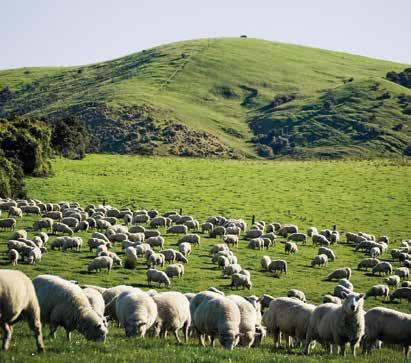

manage their herds while promoting cow health and well-being.
HARNESSING THE power of data and technology has become increasingly important in the dairy farming, because milking cows is a physically demanding and time-consuming task for dairy farmers, according to Waikato Milking Systems.

By utilising advanced tools and systems, farmers can optimise every aspect of the dairy farming process, from herd management to milk production and beyond.
The company says utilising data-driven insights and automation allows dairy farmers to make informed decisions that increase efficiency, productivity, and profitability, while making it easier than ever for farmers to monitor and
Headquartered in the heart of dairy country, Waikato Milking Systems says that automated milking technology minimises physical strain on employees, reduces the risk of repetitive strain injuries, and promotes a better worklife balance by freeing up time for other tasks and activities, ultimately reducing the likelihood of staff turnover and burnout.
Offering a broad range of technologies, their automatic cup removers, such as the ECR Plus, are said to provide a consistent milking process that prevents udder health issues caused by over or under-milking, thereby reducing the need for antibiotics or other treatments, so pro-
moting the overall health and well-being of the herd. Additionally, ECR Plus improves the milking experience for cows, reducing stress and discomfort, resulting in a more efficient and comfortable process.
The company says its DairyHQ Dairy Man-
agement solution offers real-time data on cow health and milk production, allowing farmers to detect potential issues early and take appropriate measures, contributing to better herd health and increased milk yield.
A range of milk metering systems, from a basic
Yield Indicator to the more advanced Electronic Milk Meter, measure the volume of milk produced by each cow during milking, providing real-time data for efficient dairy parlour management. This helps contribute to a streamlined operation and optimal herd health
and productivity, allowing operators to focus on other tasks.
With technology such as SmartSPRAY – an inbail teat spray system or our WalkoverSPRAYER – an in-race teat spraying system, the process of applying a disinfectant or sanitiser solution to the
cow’s teats after milking is automated, preventing mastitis and maintaining good udder health.
Waikato Milking Systems says its range offers customised milking and automation solutions to suit farms of different sizes and herd requirements.
Farmers can choose the level of automation that best suits their needs, even upgrading in stages, to improve performance, productivity, and profitability while promoting the health and well-being of employees and cows.
Harnessing the power of data and technology is no longer a luxury, but a necessity for those who want to remain competitive and profitable in today’s ever-evolving industry, the company says.
www.waikatomilking.com

PROUDLY CARRYING the Made in New Zealand badge, Te Pari says the Lenta Cattle Crush range is the result of listening to the needs and feedback of farmers.
Many of its features are based on valuable input from users in NZ and abroad, making livestock handling easier, safer and more efficient.
One of the standout features of the Lenta range is its hot-dip galvanized steel frame, providing strength, durability and longevity in the harshest farm conditions. The company says this makes it a reliable and cost-effective investment for farmers.



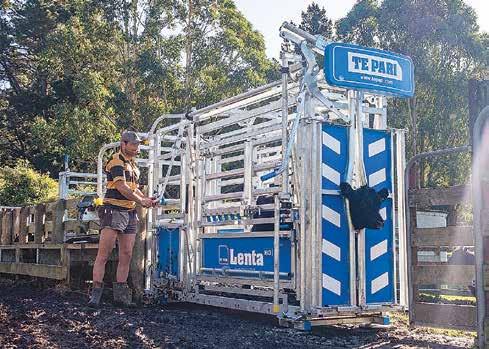
Incorporating non-slip flooring, the Lenta range is
and safety for farmers and animals. The head bail of the crush comes with a lifetime guarantee on the lockbox,

The top of the range MX Crush features an easy-touse parallel squeeze operation, allowing users to easily
handling efficiency, but also reducing the risk of injuries to animals and the handlers.
ACCORDING TO the DairyNZ’s lameness cost calculator, lameness costs over $500 per lame cow – due to lost production, having to withhold milk from treated animals or reproductive problems.
While we cannot completely eradicate lameness, early detection and prompt effective treatment can greatly reduce its impact on the health of our herds and the profitability of our businesses.
Lameness is a symptom of pain, but by the time a cow has become lame enough to show us, or drop to the back of the mob and change her behaviour, meaning her activity and rumination has dropped off, her dry matter intake has already reduced significantly. This results in reduced energy availability for reproductive performance, milk production and self-preservation.
OmniEye, a New Zealandbased company, has developed a non-obtrusive, non-wearable livestock monitoring system
machine learning. This innovative technology allows farmers to monitor the health and welfare of their herds and detect lameness at an earlier stage. OmniEye monitors the herd as they leave the shed, in their usual position in the pecking order, capturing their natural gait without any attempt to conceal discomfort.
Sean Ginders of Medstone Dairy emphasises the system’s effectiveness: “OmniEye spots lame cows early, while they’re still in the middle of the mob so we can do something about it before they become a problem and drop to the back.”
By leveraging OmniEye’s intelligent technology, dairy farmers can gain crucial insights into the health of their herd, detect lameness early, and take proactive measures to mitigate its impact. Geoff Colson from Riverstone, has already experienced the benefits of this system.
“I’m spending more time at the computer, but it is valuable time because this system is spot-
VISITORS TO Fieldays 2023 can take note of machinery for nature conservation and grounds management at the AgriQuip stand (C24)
Balancing agricultural land use with care of the environment can be challenging but is not impossible.
ack in its homeland, a 2.8 metre Irish Major Cyclone rotary mower is helping the RSPB NI and its Countryside Land Management Service (CLMS), along with conservation groups and farmers, who are working together to protect natural habitats and indigenous biodiversity.
Part of the CLMS work is to control rushes and scrub around the Lough Beg National Nature Reserve in Northern Ireland.
“It is important that the dense rushes are controlled, and scrub is not given a chance to take over, which could potentially lose the very species and habitats for which it was designated,” says Paul Trimble, CLMS business manager at RSPB NI.
Farmers sharing the ground allow stock to graze the area during the summer period, and CLMS undertakes mechanical vegetation control using the Major Cyclone mower during the winter months.


“The Cyclone mower is more reliable and requires less power consumption than flail machines, which means lower fuel consumption and reduced carbon emissions,” says Trimble.
“They also leave a better, open stubble finish, that the waders find more acceptable for nesting.” www.agriquip.co.nz
 MARK DANIEL markd@ruralnews.co.nz
MARK DANIEL markd@ruralnews.co.nz

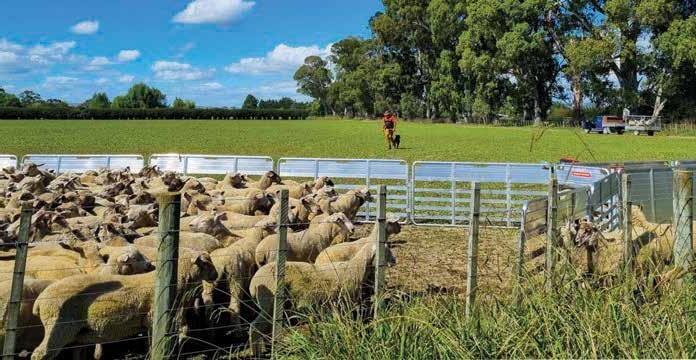
INTRODUCED BY The Power Farming Group in 2021, the Humus mulcher range has a diverse range of products to suit the vineyard, orchard or green space maintenance markets.


Manufactured near Lake Constance in the south of Germany, the business has operated for more than 65 years and has a footprint of around 16,000 square metres.

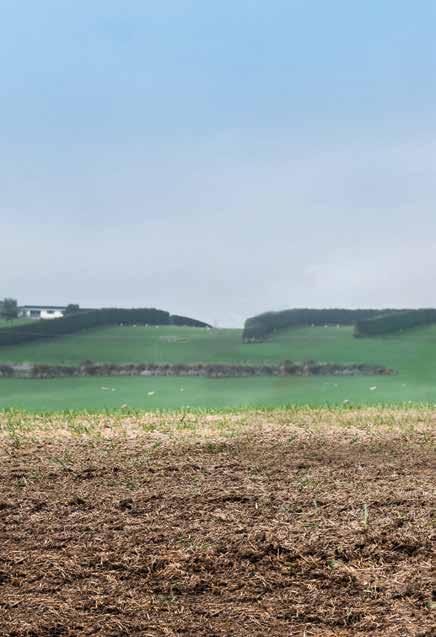
One machine generating a lot of interest is the HP 200 Mulcher that can be configured to suit several different situations. Rear mounted, the machine offers an effective cutting width of 2 metres, that can be complemented by a front mounted unit to deal with up to 5.4 metres in a
single pass.
Said to be ideal for cutting paths, field borders, embankments, ditches and road verges, the SP 200 features a cleverly designed and engineered parallelo-

gram frame to carry the mulcher, allowing the machine to be used behind the tractor or offset to the left- or righthand sides. Hydraulically actuated lock-out valves ensure a smooth
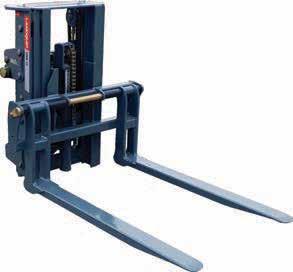
transition from the rear to offset position, allowing precise adjustments to be made on the move, maybe to avoid obstacles. The mounting of the cutterhead also allows vertical oscillation of up
to 90 degrees upwards and 60 degrees downwards, via hydraulic con-
trol, meaning banks or the sides of drains are easily dealt with. Offered with Cat II or III connections, PTO input is 540rpm from the tractor, to a gearbox from where a V-Belt system takes power to the cutterhead.
Integral to the mounting system is a mechanical break back system allowing the mulcher to move rearwards in the event of hitting any immoveable objects.

Weighing in at 1000kg, the 140mm diameter rotor tube can be equipped with a choice of Y type, fine cut, or claw style blades or universal flails. The unique Safety Mulcher option features helical mounting flanges

across the full width of the wear-resistant rotor, that takes replaceable sectional cutters with a multi-toothed blade design. The format is said to allow higher peripheral speeds for a cleaner finish, well reduced debris, but more importantly, resists the ejection of foreign objects or debris during impact or when the mulcher is lifted.
Cutting height is controlled via a full width rear roller assembly that in turn can be complemented by optional side skids for more precise control.

farm machinery, and in particular, drills.

WITH A history that dates back to 1865, the name Duncan is synonymous with no-nonsense
Pioneers in early disc drill manufacture in the 1950’s, the arrival of the Duncan 730 Multi-Seeder in the 1970’s saw the first
triple-disc drill, purposely designed to meet the needs of the increasingly popular direct drilling concept. Over the ensuing years, the 734 arrived in the 1980’s, the Enviro

740 in the 1990’s and the Enviro 3000e in 2005, the latter superseded by the ATD 30 in 2019.
Having been acquired by Giltrap Engineering in 2018, the company set its sights on developing a larger triple disc drill that was larger than the current 3.5 metres. The concept required a folding design, the retention of many current design features and, of course, a nationwide dealer network.

Working from a clean sheet, the process was started by bringing together farmers, contractors, and dealers to create a “wish list and must haves” needed in a new drill. These included a compact layout, ease of use and calibration and the incorporation of many tried and tested components, alongside durability and low running costs.
After a four-year design, manufacture
and development process, Duncan will use the National Fieldays to strengthen its expansive drill offering with the new ATD42 and ATD60, 4.2m and 6m, folding triple disc air seeder drills. Initially building a 6m unit, quickly followed by the 4.2m version, both units were exposed to extensive testing in traditionally “tough” areas such as the Haka Valley, Central Otago and the Central Canterbury Plains over a large number of hectares.
The result sees a drill that hydraulically folds to less than 3.1 metres transport width and, depending on application, is typically up to a metre shorter than its competitors. Up front, a ground following drag-bar is designed for hard work in the toughest conditions, with minimal maintenance.
Up top, twin 1200kg capacity hoppers are


accessed by a wide safe platform with both hoppers incorporating twin openings, meaning the main lid can remained closed if filling in windy conditions. The twin hoppers can be complemented by an optional third bin, as well as a slug bait applicator and a hydraulic loading crane.


At the business end of the machine, the 400mm front opening disc utilises a turbo flute design to break into hard ground and cut through trash. Mounted using the Duratorque system of rubber pads, instead of high wearing bearings or bushes, the flexibility provided by the system offers a high degree of movement and a swift return to the working position. Rearwards, the twin discs, supported on a parallelogram linkage with up to 400mm of movement to follow ground contours, cut an angled slot for consistent
seed and fertiliser placement at 125mm row spacing.
Seed depth adjustment is controlled by hydraulically actuated rear press wheels, complemented by hydraulically adjusted opening discs, meaning the system does away with need for time consuming turnbuckles and ratchets. Designed for easy access to the metering units, calibration is done quickly and accurately using the Duncan calibration app via a smart device, or via ISOBUS.
The drills incorporate well proven and reliable components like the Duncan electrical drive system, the metering units, fan and air delivery system, alongside the durable disc and press wheel assemblies. The manufacturer suggests tractors of 240 hp and 280+ hp for the ATD42 and ATD60 respectively. Visit site C70
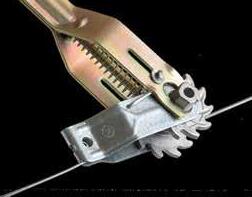
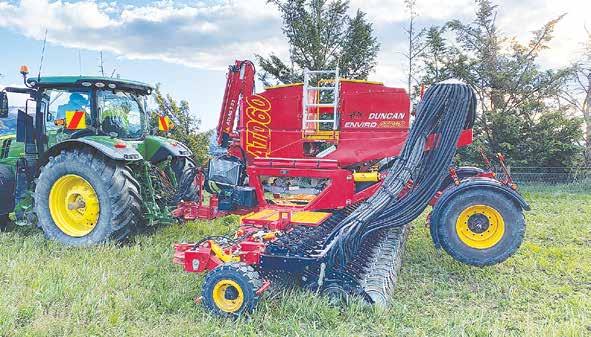
WELL KNOWN in New Zealand for more than 20 years, the Korean-built Kioti tractor brand, distributed by the Power Farming Group, has carved a niche for itself by offering productive, reliable and well-priced machines in the sub-compact, compact and agricultural utility sectors, from 22 to 115hp.

The release of the new HX Series at Fieldays will take the brand into the increasingly important agricultural sector that encompasses 100 to 150hp, with the HX1301 and HX 1401, offering 130 and 140hp respectively, peaking at 900Nm maximum torque.

Kioti national sales manager, Chris Young, sums up the new arrivals succinctly: “It’s just a bloody good tractor.”
Power is provided by Kioti’s own 4-cylinder, 3.8 litre engine, delivered in tier 2 format, meaning there is no need for emission control systems such as EGR, DPF, or DOC after-treatment.
Engine output is mated to a power shuttle/power-shift transmission, featuring four defined ranges and 8-step powershift to deliver 32F and 32 R speeds, with 24 speeds available in the key 0.4 to 12km/h working section. Hydraulically
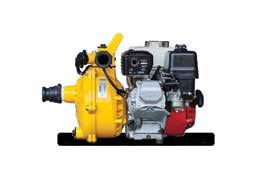
engaged 4WD combines with a rear mechanical diff lock, with a limited slip diff on the front axle, to deal with traction in sticky or difficult ground conditions. Tipping the scales at around 5 tonnes, the combination of a 2600mm wheelbase and a 4200mm turning radius means the tractor should prove useful around the farmyard, while being equally at home in the paddock.
At the business end, PTO output is 109 and 120hp respectively, offered with 540, 750 and 1000rpm speeds, while the electronically controlled rear linkage with hook ends, offers a useful 4852kg lift capacity. On the hydraulic front a closed centre, load sensing (CCLS) pump layout offers up to 118 l/min output via four rear valves, with a cabmounted, multi-function joystick with third service included in the standard equipment. A dedicated hydraulic pump of 47 l/ min takes care of power steering duties.
In the operator cabin, a sense of space is created with an overall width of 1700mm, complemented by a 5-post cab design, meaning unobstructed views to the offside of the tractor. To the right of the air-suspended swivel seat, a multi-function armrest takes care of key functions such as throttle
control, powershift and auto-powershift functions and the rear linkage operation.
A wide range of standard equipment includes an instructor seat, a tilt and telescopic steering wheel function, air conditioning and an audible park brake alarm. The company has also taken things a stage further with a PTO cruise speed function, a fridge and heating cabinet, multiple

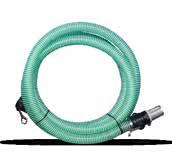

drinks holders, Bluetooth radio and a panoramic sunroof with shade blind.
Around the tractor specifications also include 420-70R28 front and 520-70R 38 rear radial tyres complemented by front fenders. Attention to detail includes easy access to daily maintenance check points, a battery isolator and rear external linkage controls on the rear fenders. www.powerframing.co.nz
DRONES ARE gaining more popularity in the rural sector as users realise they offer the potential to improve productivity, health and safety and ultimately reduce costs.
Indeed, while drone use probably started out as taking photos and making videos from a different perspective, they have now moved into the realms of crop assessment, monitoring of remote areas and water lines and targeted weed or crop spraying.
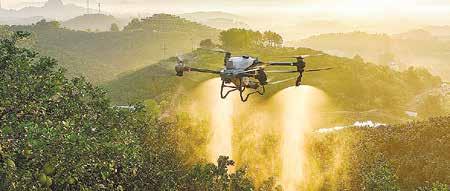
Ferntech, the distributor for the well known DJI range, returns to Fieldays 2023, with several examples of what drone adoption has to offer.

The DJI Agras T40 Spraying Drone is designed for precision spraying
and spreading, allowing operators to accurately spot spray plants, reducing the cost of expensive chemicals, while eliminating costs such a diesel, with environmental benefits such as reduced emissions, no ground compaction or bank destabilisation.



Equipped with a 40L tank capacity, the T40 can efficiently spread and spray over 120ha per day, flying across steep terrain, boundaries, and gullies in a fraction of the time and with zero risk.

For livestock farmers, the DJI Mavic 3 Enterprise Barking Drone, easily herds and move your livestock across large distances, by combining a loudspeaker with recorded audio, such as a dog’s bark or a siren, at the same time cutting fuel usage, offering improved health and safety outcomes, and freeing up time taken for manual inspections.
In addition, with a 20-megapixel camera equipped with a 56x hybrid zoom function,
THE NEED for a portable shearing/ clipping machine that could be used in stockyards prompted David Short to invent the Handypiece back in 2008.


users gain greater visibility and flexibility and the ability to cover more ground in less time.
This might include identifying and locating animals, detecting leaks in tanks and irrigation lines, or checking boundary fences.
Ease of use is enhanced with a clever waypoint feature, allowing operators to set up a predetermined route, from where the drone automatically flies along the predetermined path.
Visit sites PB9 and PB11


Offering the main benefit of working anywhere without mains power, Handypiece allows users of all abilities to keep on top of those dirty jobs, resulting in better animal health and efficiency. Cleverly designed, the brushless motor means the battery lasts longer, making it possible to crutch from 300-400 sheep with a single charge.
The Handypiece Pro has the added feature of variable speed from 2600 – 3500rpm, allowing dagging, crutching and trimming cows’ tails at a midspeed of 2800rpm, while those wanting a superior cut while shearing can run at the maximum speed. In the case of alpaca shearers, they can use a traditional, slim handpiece, while reducing the speed to that of a clipper.


Being a traditional handpiece, the device takes all standard combs & cutters of any brand the user prefers, yet is still available at a reasonable price. The Handypiece also can be customised for left-handed users, or alternatively assembled with the cord exiting
from the middle of the motor, meaning the unit can be used by both left, and right-handed operators.
During the National Fieldays the kit will feature two 6 amp/hr lithium-ion batteries, a battery charger, heavy-duty leather belt, holster and pouch, alongside a 5m extension cord and carry bag. www.handypiece.co.nz
•

A FREE smartphone-based app makes it much easier to calibrate current Giltrap Duncan electric drive and mechanical drive drills but works equally well on older model Duncan Renovator and Enviro drills.
Offering easy-to-follow, step-by-step guides to calibrate and make mechanical adjustments to your drill, the app removes the need to refer to manuals or use the tractor’s in-cab controller.
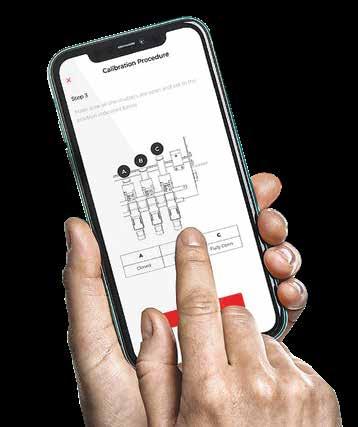
Once downloaded from the Apple App Store or Google Play, you can link your smartphone to the Smart Ag Wi-Fi enabled monitor in the tractor cab, using the device to do all the steps necessary to calibrate the drill.
With the app you do the sampling and enter the results on your phone while stand ing next to the drill, out side the cab, removing the need to climb into the cab to enter results on the monitor. The app pro vides drop down menus to select the type of crop you are about to sow and the preferred sowing rate.

When using a mechan ical ground-drive drill with seed or fertiliser, the app confirms settings for the gearbox, flaps and shut ters, alongside the number

of turns to conduct a calibration. Once you have weighed the sample and entered it into the app, adjustments are recommended, and another sample is conducted to confirm accuracy.
When used with a Smart Ag Wi-Fi enabled electric drive drill, once crop type and sowing rate are selected, the app tells the drill to release a sample. Weighing the sample confirms the settings, while all the details are automatically sent back to the drill monitor in the tractor cab.
Picture diagrams show each part of the calibration process and how to set up the drill, said to be ideal for new operators, or an older machine only used infrequently. Offering the ability to calibrate multiple machines, a further benefit is once downloaded to a device, with the corresponding drill model, a cellular connection isn’t necessary to use
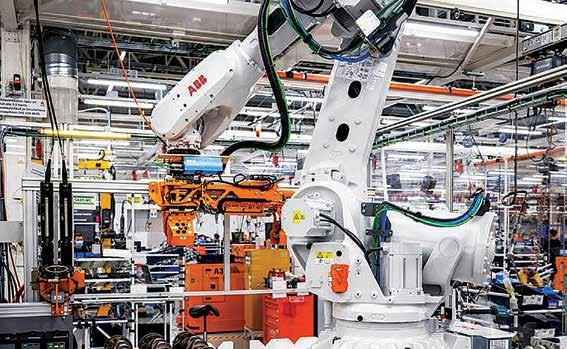
GLOBAL TRACTOR manufacturer AGCO – the home of Massey Ferguson, Fendt and Valtra – has released a totally new engine design.
This comes as a result of a €1 billion investment at the Linnavuori engine production plant, near Nokia in Finland.
With what appears to be a growing list of alternative fuels, which hold potential for future use – including as hydrogen and natural gas, in both compressed and liquid forms. AGCO suggests that the way forward to utilise these “alternative” fuels is a new engine, designed from the ground up to be compatible with them – rather than adapting existing engines.
The company claims their new CORE engine family can be easily developed to run efficiently with different fuels as they become
• The toughest cutterbar on the market.
• SafeCut & SmartCut systems.
adopted as replacements for fossil diesel.
Compression ignition engines have been with us for over 130 years and remain the most practical solution in many applications. While electric vehicles are becoming more common, AGCO notes that battery capacity is not yet enough for off-road machinery applications, except for compact machinery – typically less than 75hp.
It says the chief advantage of diesel fuel is that it has a high energy density and is reasonably safe and easy to handle.
Thermodynamic principles also mean that higher compression ratio engines are more efficient.
Unfortunately, however, engineering constraints created in handling the higher temperatures involved puts a limit on their ulti-

mate size.
The first engine from the new family is the CORE75. This is a 7.5L block, which delivers 1,450 Newton-meters (Nm) of torque at 1,300rpm (revolutions per minute). This is the highest in its power class, according to AGCO. By reducing engine speed at maximum torque by 200rpm, fuel economy is improved, with a specific consumption of only 188g/ kWh.
Already fitted in the latest Fendt Vario 700 series tractors, the company claims it marks not only a new generation of flexible engines, but also a firm commitment to the internal combustion engine as a power unit for many years yet. Designed as a multi-fuel engine, the CORE units are likely to be seen across the whole AGCO range and beyond. – Mark Daniel
• Front, rear or trailed options - with or without conditioner.
Working width from 4.6m to 11m
• Rotor construction is of the highest strength and rigidity to allow optimised tine function.

• New Optiturn 3D tines to spread the swath perfectly.
Working width from 6.4m to 9.3m
• Low maintenance, nimble & designed for heavy silage conditions.



• DuraMax Cam Track ensures superior shaped windrows.

Produce exceptional results with the Krone machinery range. Invest in longevity and quality. Invest in the best.
 MARK DANIEL markd@ruralnews.co.nz
MARK DANIEL markd@ruralnews.co.nz
WHILE THERE have been good results for the global machinery manufacturers during the Covid period, there are



some signs of a slowdown.
The reasons cited include raw materials and component supplies, rising production costs and long lead times.


Reassuringly, many


manufacturers seem to see a positive future, either by acquisition, or expansion of their existing facilities. Many are investing huge sums to increase production capability and efficiency by
incorporating the latest technologies.
One such company to do so is Vaderstad which has recently acquired the inter-row interests of Thyregod to enter the mechanical weeding


sector. The company has now embarked on a factory expansion of 12,600 square meters (2.9acres) in the Swedish town of Vaderstad.

This increase in production capacity is said to meet the aims of increasing production to 10,000 machines annually by 2028. The decision to invest is no doubt driven by increased demands for its products in recent years that has seen turnover increase from €237m in 2017 to €550m in 2022.
This new investment, on the tail of investments in new buildings during 2021 which amounted to €11 million, is due to be ready for use by 2024 and will be complemented by the expansion of the current production area.
The expansion will see two 6300 square
metre halls added and connected to the existing factory, creating a total production area of approximately 70,000m² (16 acres). The extra space will create room for manufacturing and painting, alongside a more efficient flow through the factory for current and future ranges of machinery.
The Swedish Vaderstad facility currently produces machines for all global sales regions. This is except for North America, where production facilities are located at Langbank in Canada, and Wahpeton, US. Väderstad’s tillage and seeding products are imported and distributed by the Palmerston North head-quartered Norwood Group. www.norwood.co.nz
A FLEET of new tractors and a telehandler got the big thumbs up from the permanent staff at Mystery Creek recently.
This came after the New Zealand National Fieldays Society received the Case IH machinery as part of its sponsorship relationship with the agricultural machinery manufacturer.




The Farmall 50B, a brace of Farmall U110’s and the Farmlift 742 Telehandler will be used to support the society’s day-to-day operations at Mystery Creek Event Centre – including the maintenance of its 114-hectare property.
“We are thrilled to receive this machinery from our premier sponsor,” says New Zealand National Fieldays Society chief executive, Peter Nation. “This equipment will be of great assistance to us as we get the site ready for exhibitors to pack in for Fieldays, as well as maintaining our large site on a daily basis.”
Away from the major Fieldays event, the tractors and telehandler will be used to assist the operations team with seeding and mowing, sanding roads, flattening surfaces – as well as shifting and lifting heavy equipment and material around the event site.
“We are proud to support Fieldays by providing this machinery to help with their operations,” said Murray Grant, CNH Industrial Commercial business manager – New Zealand.
“We know these tractors and the telehandler will be valuable assets to the Society and provide invaluable support across a range of tasks.”
HOUSING JOHN Deere’s largest production facility outside of North America, the German Manheim plant, recently celebrated the milestone of producing its two millionth tractor.

Having taken 37 years to hit the one million mark, it has been a further 30 years to reach this latest milestone.

An impressive achievement given that as average horsepower has increased, volumes and sales have declined in most of the major markets around the world during the last two decades.
Looking back over the Manheim story, in the early 1950s, John Deere was looking at expansion overseas, particularly in Europe. This initially fell at the first hurdle after plans to build a Scottish factory were stymied by a



change in British government policy.
At around the same time, they were approached by a German banker trying to sell a near bankrupt company called Lanz. Despite its pre-war market share of 40% with its Bulldog model, the company was

failing to keep up with more modern designs.
Undecided on the relative merits of establishing a new factory or buying an existing manufacturer, John Deere initially rejected the takeover offer in 1956, before a rethink saw it agree to buy Lanz in a deal that
came with its factory at Manheim.

The deal also included Lanz’s stock of unsold tractors, which were subsequently painted in the well-known yellow and green livery and sold as John Deeres.
Now, all of John Deere’s mid-range


tractors are built at Mannheim.
The two millionth example was a 6R 250, wrapped in portrait photos of more than 300 staff as a thank you gesture. The tractor was unveiled in the presence of John Deere chief executive John C. May and
will eventually be given a place of honour in the factory museum next to the one millionth tractor – a JD 6400.
Currently, the plant is undergoing an $80m investment programme encompassing environmental technology to sig-
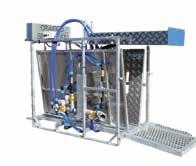
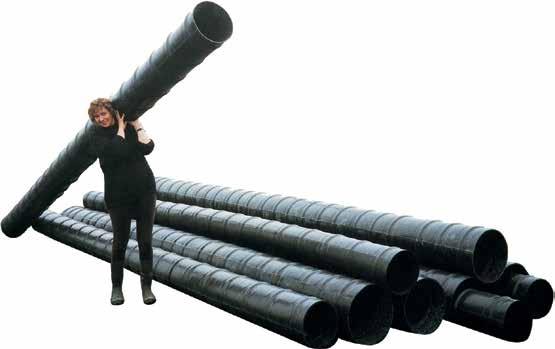


nificantly reduce energy consumption and emissions, alongside reducing waste, including water, and a lowering of noise levels. In all, the plant currently employs 3300 staff and holds the title of the biggest tractor manufacturing plant in Europe.


























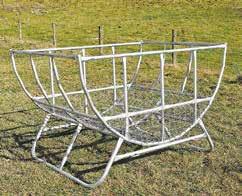
A STREAMLINED NEW SOLUTION.
We’ve again raised the engineering bar in outboard motors with an integrated steering system for our flagship DF300B and DF350A 4.4-litre V6 models.
The system incorporates a simple rack and pinion design and eliminates the requirement for a conventional steering cylinder’s integration onto the front of the outboard to control the steering axis
• Fits neatly inside transom bracket, providing a cleaner and uncluttered appearance inside the motor well
• No impacting the well or transom when tilting the outboard

• Provides more reliable steering, control and operation.

THE TECHNICAL ADVANCEMENTS CONTINUE.
Our DF300B and DF350A models now feature a newly designed gearcase with a smaller frontal projected area, reducing drag and increasing efficiency which helps to increase average top speed by two percent.
The redesign also has added an oil circulation mechanism that lowers gear oil temperature, leading to increased durability. It also reduces the amount of gear oil required to fill the lower unit from 3.2 to 2.8 litres.
Finally, an in-water gear oil change feature now improves maintainability, allowing the motor to be tilted and the lubricant replaced using a new dedicated fitting. Contact your local Suzuki Marine dealer for more information or visit suzukimarine.co.nz
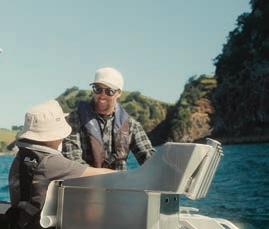
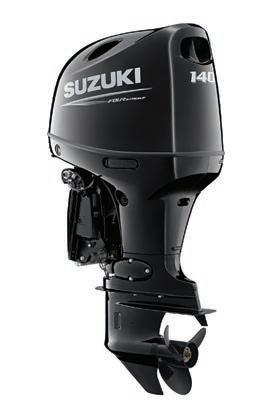

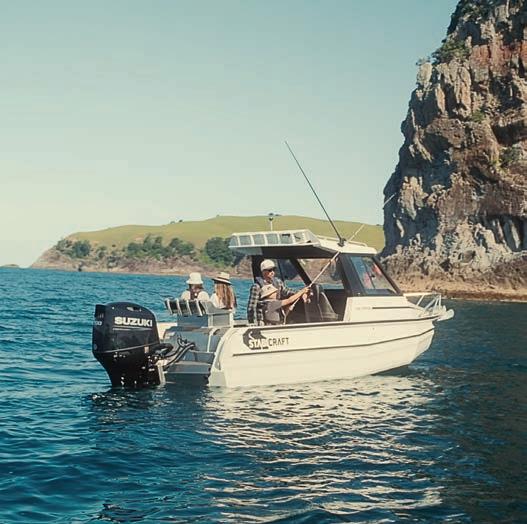
Enhance your DF300B or DF350A with the autopilot controls of the Furuno powered FishHunter™ Drive, with precision navigation of routes and advanced fishing features for anglers while jigging or trolling.

$6,095
EVERY DF300B OR DF350A




